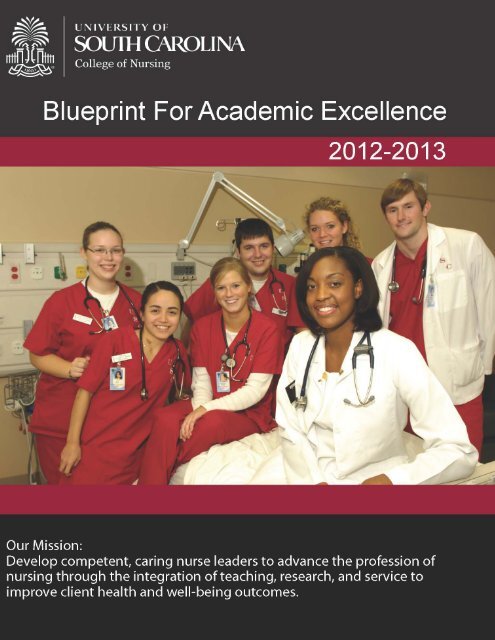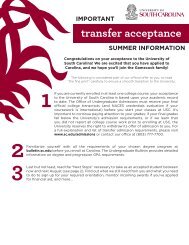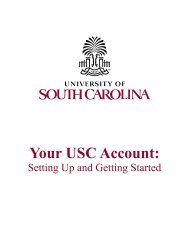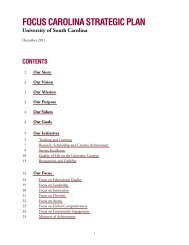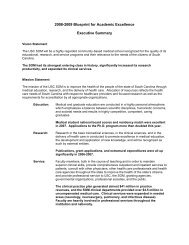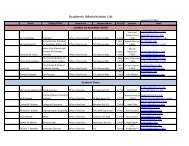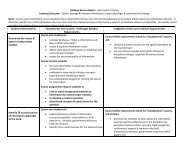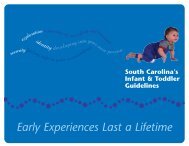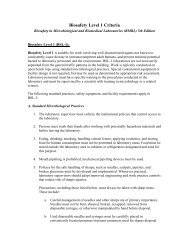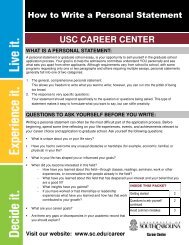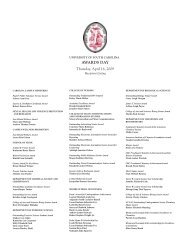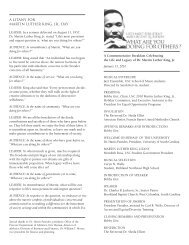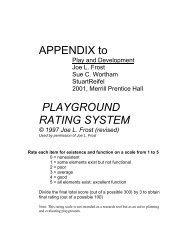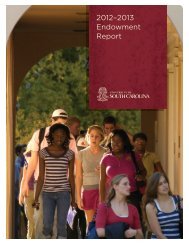Blueprint for Academic Excellence at USC College of Nursing
Blueprint for Academic Excellence at USC College of Nursing
Blueprint for Academic Excellence at USC College of Nursing
Create successful ePaper yourself
Turn your PDF publications into a flip-book with our unique Google optimized e-Paper software.
<strong>Blueprint</strong> <strong>for</strong> <strong>Academic</strong> <strong>Excellence</strong> <strong>at</strong> <strong>USC</strong><br />
<strong>College</strong> <strong>of</strong> <strong>Nursing</strong><br />
2012 – 2013<br />
Prepared by:<br />
Peggy O. Hewlett, PhD, RN, FAAN<br />
Dean and Pr<strong>of</strong>essor<br />
Spring 2012<br />
DRAFT COPY<br />
2
<strong>USC</strong> <strong>College</strong> <strong>of</strong> <strong>Nursing</strong><br />
<strong>Blueprint</strong> <strong>for</strong> <strong>Academic</strong> <strong>Excellence</strong><br />
Executive Summary<br />
Spring 2012<br />
Mission: Develop competent, caring nurse leaders to advance the pr<strong>of</strong>ession <strong>of</strong> nursing through the<br />
integr<strong>at</strong>ion <strong>of</strong> teaching, research, and service to improve client health and well-being outcomes.<br />
Vision: To achieve prominence as a n<strong>at</strong>ional leader in the collabor<strong>at</strong>ive use <strong>of</strong> revolutionary and<br />
innov<strong>at</strong>ive pr<strong>of</strong>essional nursing practices.<br />
Core Values:<br />
Innov<strong>at</strong>ion - Cultiv<strong>at</strong>ing flexibility, cre<strong>at</strong>ivity, and adaptability<br />
Integrity - Upholding honesty and promoting trustworthiness<br />
Caring - Perpetu<strong>at</strong>ion <strong>of</strong> an <strong>at</strong>mosphere <strong>of</strong> compassion, emp<strong>at</strong>hy, and kindness<br />
<strong>Excellence</strong>- Relentless pursuit <strong>of</strong> quality in research, teaching, service, and practice<br />
Leadership - Empowering others to achieve a collabor<strong>at</strong>ive vision<br />
Pr<strong>of</strong>essionalism- Congruence <strong>of</strong> competency, engagement, and ethical behaviors<br />
2012-2013 Str<strong>at</strong>egic Planning Goals:<br />
Trans<strong>for</strong>m <strong>Nursing</strong> Educ<strong>at</strong>ion<br />
Sustain Research <strong>Excellence</strong><br />
Nurture a Thriving Practice Environment<br />
Maximize Resources<br />
Maximize Core Missions through Effective Technology<br />
Threaded through the long-term goals are two str<strong>at</strong>egic priorities included to assure goal effectiveness:<br />
Effectively Market the Core Mission Activities<br />
Lead through Collabor<strong>at</strong>ion with Key University and External Partners<br />
Top ten nursing programs: Universities <strong>of</strong> Washington, Pennsylvania, Cali<strong>for</strong>nia-San Francisco,<br />
North Carolina-Chapel Hill, Michigan, Illinois-Chicago, & Pittsburgh; Johns Hopkins; Yale; and Oregon<br />
Health Science University.<br />
Peer programs: Universities <strong>of</strong> Kentucky, Alabama-Birmingham, Kansas (KUMC), Florida, & Colorado.<br />
<strong>College</strong> <strong>of</strong> <strong>Nursing</strong> strengths: a vibrant str<strong>at</strong>egic plan; excellent faculty & staff; outstanding student<br />
applicant pool <strong>for</strong> all programs; quality educ<strong>at</strong>ional programs, including on <strong>USC</strong>-Lancaster & <strong>USC</strong>-<br />
Salkeh<strong>at</strong>chie campuses; st<strong>at</strong>e-<strong>of</strong>-the-art simul<strong>at</strong>ion & on-line course capabilities; productive core <strong>of</strong> nurse<br />
researchers; practice plan with exciting faculty opportunities; experimental curriculums addressing faculty<br />
& clinical site shortages (Dedic<strong>at</strong>ed Educ<strong>at</strong>ion Unit & site <strong>for</strong> the NCSBN landmark p<strong>at</strong>ient simul<strong>at</strong>ion<br />
study); SC Center <strong>for</strong> <strong>Nursing</strong> Leadership; Office <strong>for</strong> Healthcare Work<strong>for</strong>ce Research in <strong>Nursing</strong>; an<br />
active development Partnership Board; & a 55-year history <strong>of</strong> uninterrupted n<strong>at</strong>ional accredit<strong>at</strong>ion <strong>of</strong> all<br />
nursing programs.<br />
Points to work on next year include: successful transition between Deans; recruitment <strong>of</strong> tenure-track<br />
faculty; renov<strong>at</strong>ion <strong>of</strong> expanded space in the clinical simul<strong>at</strong>ion lab; reclam<strong>at</strong>ion <strong>of</strong> 6 th floor to allow<br />
expansion space; providing sufficient support <strong>for</strong> nurse researchers; revitaliz<strong>at</strong>ion <strong>of</strong> PhD program aligned<br />
with research foci; and seek additional resources to support growth within the college.<br />
3
<strong>USC</strong> <strong>College</strong> <strong>of</strong> <strong>Nursing</strong><br />
<strong>Blueprint</strong> <strong>for</strong> <strong>Academic</strong> <strong>Excellence</strong><br />
Spring 2012<br />
Overview <strong>of</strong> the <strong>USC</strong> <strong>College</strong> <strong>of</strong> <strong>Nursing</strong> 2009-2012 Str<strong>at</strong>egic Plan<br />
The <strong>USC</strong> <strong>College</strong> <strong>of</strong> <strong>Nursing</strong> began a new <strong>for</strong>m<strong>at</strong> <strong>for</strong> str<strong>at</strong>egic planning in the 2005-2006<br />
academic year, utilizing a process th<strong>at</strong> includes input from faculty, staff, students and external<br />
stakeholders. For the past seven years, the CON has fe<strong>at</strong>ured a one-page map with clearly<br />
identified mission, vision, goals and str<strong>at</strong>egic priorities. Under the direction <strong>of</strong> the CON Dean<br />
and assisted by a skilled str<strong>at</strong>egic planning consultant, the first 3-year plan was developed in<br />
2006. Annual reviews <strong>of</strong> this plan are conducted with revisions to the plan as some str<strong>at</strong>egic<br />
priorities were met during th<strong>at</strong> particular year and others changed in level <strong>of</strong> importance. In<br />
essence, the mission and vision stayed the same, but the goals were adjusted and priorities were<br />
redefined. Using this methodology, the CON has been very successful in meeting defined goals,<br />
tying the budget to the str<strong>at</strong>egic plan, and aligning the work <strong>of</strong> all faculty and staff to the overall<br />
plan. Annual reviews <strong>for</strong> faculty and staff are measured by linking individual work and success<br />
to th<strong>at</strong> <strong>of</strong> the CON via the str<strong>at</strong>egic planning process. Annual evalu<strong>at</strong>ion <strong>of</strong> a particular year's<br />
action plans has been acknowledged with the 2011-2012 Str<strong>at</strong>egic Map included in this<br />
document.<br />
As the faculty and staff reviewed the effectiveness <strong>of</strong> this year's plan, it is important to<br />
note th<strong>at</strong> during the last three fiscal years, the University has continued to have to adapt to<br />
un<strong>for</strong>eseen and unprecedented st<strong>at</strong>e budget cuts -- and in spite <strong>of</strong> this challenge, the CON faculty<br />
and staff have taken a bold approach to the future -- our vision being to be counted among the<br />
leading colleges <strong>of</strong> nursing in this n<strong>at</strong>ion by taking a revolutionary approach to the delivery <strong>of</strong><br />
nursing educ<strong>at</strong>ion in the classroom, the clinical setting and in scholarly work.<br />
How we intend to accomplish this is mapped out through our innov<strong>at</strong>ive 2009-2012<br />
Str<strong>at</strong>egic Plan, and the <strong>USC</strong> <strong>College</strong> <strong>of</strong> <strong>Nursing</strong> <strong>Blueprint</strong> <strong>for</strong> <strong>Academic</strong> <strong>Excellence</strong>.<br />
4
<strong>USC</strong> <strong>College</strong> <strong>of</strong> <strong>Nursing</strong><br />
2012-2013 Str<strong>at</strong>egic Plan<br />
Goals <strong>for</strong> the 2012-2013 <strong>Academic</strong> Year - The <strong>College</strong> <strong>of</strong> <strong>Nursing</strong> works from a 3-year str<strong>at</strong>egic plan,<br />
with goals and action plans upd<strong>at</strong>ed annually. There<strong>for</strong>e, the five goals listed below are key foci <strong>for</strong> the<br />
next academic year -- although they may well take more than one year to complete. In fact, with the<br />
exceptions <strong>of</strong> Goal 2-D and Goal 4-D, the remainder <strong>of</strong> the 2011-2012 str<strong>at</strong>egic map has been upd<strong>at</strong>ed as<br />
action plans th<strong>at</strong> are still underway and extending into the next academic year (See 2012-2013 Str<strong>at</strong>egic<br />
Map on previous page). There have been no changes in the mission, vision, or goals this year – and these<br />
remain in congruence with those set by the University Board <strong>of</strong> Trustees and the Provost. The primary<br />
emphases <strong>for</strong> 2011-2012 were to stabilize financially and to assure quality and effectiveness <strong>for</strong> NCLEX<br />
improvements and a successful Commission on Collegi<strong>at</strong>e <strong>Nursing</strong> Accredit<strong>at</strong>ion (CCNE)<br />
reaccredit<strong>at</strong>ion. NCLEX-RN annual pass r<strong>at</strong>es <strong>for</strong> first time test-takers were well above the n<strong>at</strong>ional<br />
average <strong>for</strong> 2011 (94.5% <strong>for</strong> <strong>USC</strong> CON). The CCNE reaffirmed and extended accredit<strong>at</strong>ion <strong>of</strong> the<br />
bachelor’s and master’s degree programs in nursing to 2021. The CON is one <strong>of</strong> five baccalaure<strong>at</strong>e<br />
programs selected n<strong>at</strong>ionally as a particip<strong>at</strong>ing site in the N<strong>at</strong>ional Council <strong>of</strong> St<strong>at</strong>e Boards <strong>of</strong> <strong>Nursing</strong><br />
(NCSBN) N<strong>at</strong>ional Simul<strong>at</strong>ion Study, a landmark compar<strong>at</strong>ive effectiveness RCT <strong>of</strong> simul<strong>at</strong>ed and<br />
traditional clinical nursing learning experiences. The st<strong>at</strong>e <strong>of</strong> the <strong>USC</strong> <strong>College</strong> <strong>of</strong> <strong>Nursing</strong> is sound.<br />
The following outlines the 2012-2013 CON Str<strong>at</strong>egic Goals and rel<strong>at</strong>ed Action Plans and incorpor<strong>at</strong>es<br />
metrics th<strong>at</strong> support those <strong>of</strong> the <strong>USC</strong> Provost.<br />
Goal 1 – Trans<strong>for</strong>m <strong>Nursing</strong> Educ<strong>at</strong>ion<br />
The United St<strong>at</strong>es is facing a revolutionary transition in the healthcare delivery model. While the<br />
recession has cre<strong>at</strong>ed a market where older and part-time nurses have decided to work longer or full-time,<br />
the nursing shortage still exists across the country and here in South Carolina. Wh<strong>at</strong> we have seen is a<br />
temporary relief in the shortage, but as noted from the American Associ<strong>at</strong>ion <strong>for</strong> <strong>College</strong> <strong>of</strong> <strong>Nursing</strong><br />
(AACN): "In the l<strong>at</strong>est December 5, 2011, Health Affairs journal, an article titled Registered Nurse<br />
Supply Grows Faster than Projected Amid Surge in New Entrants Ages 23-26 was published. This article<br />
focused on a large cohort <strong>of</strong> younger nurses entering the pr<strong>of</strong>ession and the impact this may have on the<br />
future work<strong>for</strong>ce. Funded by the Gordon and Betty Moore Found<strong>at</strong>ion, this study was conducted by Drs.<br />
David Auerbach, Peter Buerhaus, and Douglas Staiger who found a 62% increase in the number <strong>of</strong> 23-26<br />
year olds who became registered nurses (RNs) between 2002 and 2009. Though welcome news, given the<br />
rapid aging <strong>of</strong> the nursing work<strong>for</strong>ce, the study authors do not conclude th<strong>at</strong> nursing shortage is over<br />
given the growing demand <strong>for</strong> nursing care by older adults, new opportunities <strong>for</strong> nurses through<br />
healthcare re<strong>for</strong>m, and the need <strong>for</strong> more highly educ<strong>at</strong>ed RNs."<br />
"To this point, the authors recognize the following in the article:<br />
Considerable uncertainty persists about whether or not interest in nursing will<br />
continue to grow in the future<br />
The aging <strong>of</strong> the popul<strong>at</strong>ion is likely to increase demand <strong>for</strong> RNs <strong>at</strong> a gre<strong>at</strong>er r<strong>at</strong>e<br />
than in the past.<br />
Full implement<strong>at</strong>ion <strong>of</strong> the Af<strong>for</strong>dable Care Act and expanding roles <strong>for</strong> nurses in<br />
primary care will likely increase demand <strong>for</strong> RNs and result in future shortages.<br />
Ongoing bottlenecks in nursing educ<strong>at</strong>ion (i.e. faculty shortages, insufficient clinical<br />
training sites) could narrow the future pipeline <strong>of</strong> nurses below optimal levels."<br />
6
"Dr. Auerbach and colleagues also were concerned th<strong>at</strong> though the number <strong>of</strong> RNs prepared each year is<br />
increasing, schools <strong>of</strong> nursing may not be 'preparing the work<strong>for</strong>ce ideally suited <strong>for</strong> popul<strong>at</strong>ion needs.'"<br />
(AACN)<br />
"In response to wh<strong>at</strong> this new article may mean in rel<strong>at</strong>ion to the nursing shortage, study coauthor<br />
Dr. Peter Buerhaus, Director <strong>of</strong> the Center <strong>for</strong> Interdisciplinary Health Work<strong>for</strong>ce Studies <strong>at</strong> the Institute<br />
<strong>for</strong> Medicine and Public Health <strong>at</strong> Vanderbilt University Medical Center, shared the following comments:<br />
'The surge in young RNs reported in the article is the first really positive news th<strong>at</strong> eventually we might<br />
be able to replace the retiring Baby Boom nurses. This replacement, however, is not going to happen over<br />
the next few years, and the real impact may not be realized until the next decade. While it is truly fantastic<br />
th<strong>at</strong> we are finally seeing some evidence th<strong>at</strong> the supply <strong>of</strong> RNs is likely to grow, this growth will only<br />
occur as long as younger people remain interested in nursing, and there is no guarantee th<strong>at</strong> this will<br />
continue. Further, since we do not know specifically how much the demand <strong>for</strong> RNs will increase over<br />
the next decade, we are truly flying blind with respect to being able to project the size <strong>of</strong> a future nursing<br />
shortage. I personally do not feel confident th<strong>at</strong> even if we are able to sustain the trends reported in Health<br />
Affairs th<strong>at</strong> the supply <strong>of</strong> RNs will m<strong>at</strong>ch the large increases in demand th<strong>at</strong> are unfolding during this<br />
decade. Taking actions now th<strong>at</strong> would stop the flow into the nursing pr<strong>of</strong>ession would be very<br />
risky and an unwise gamble. By no means does our article come anywhere close to suggesting th<strong>at</strong><br />
we curtail the pipeline <strong>of</strong> new nurses into the work<strong>for</strong>ce, which may indeed thre<strong>at</strong>en the health <strong>of</strong><br />
the n<strong>at</strong>ion.'(AACN)"<br />
"AACN outlines wh<strong>at</strong> the findings mean in rel<strong>at</strong>ion to the ongoing and projected shortage <strong>of</strong> registered<br />
nurses.<br />
Though the study identifies a large infusion <strong>of</strong> younger nurses into the pr<strong>of</strong>ession,<br />
the authors do not contrast this gain with the impending wave <strong>of</strong> RN retirements th<strong>at</strong> has<br />
long been projected. With the median age <strong>of</strong> RNs currently 46 years old and the largest<br />
cohort <strong>of</strong> nurses now in their 50s, a significant portion <strong>of</strong> the nursing work<strong>for</strong>ce is<br />
expected to retire over the next 10-15 years. Without a clear assessment <strong>of</strong> how many<br />
older nurses are leaving the pr<strong>of</strong>ession compared with the number <strong>of</strong> younger entrants, it<br />
is difficult to determine the size <strong>of</strong> future shortages.<br />
Compounding this issue is the fact the current downturn in the economy has disrupted<br />
typical RN employment p<strong>at</strong>terns with retired nurses coming back to work and part-time<br />
nurses assuming full-time roles. When the economy recovers and old work p<strong>at</strong>terns<br />
resume, even more nurses are expected to leave their positions, which will further reduce<br />
the supply <strong>of</strong> working RNs.<br />
The study used projections th<strong>at</strong> depend upon continued, robust interest and growth<br />
in the number <strong>of</strong> new nursing pr<strong>of</strong>essionals entering the pipeline, which may not be<br />
the case in the long run. The authors cite ‘considerable uncertainty’ in whether or<br />
not this level <strong>of</strong> interest will persist in the coming years. In fact, misleading reports<br />
about the end <strong>of</strong> the nursing shortage may indeed signal prospective nurses to seek<br />
careers in other fields.<br />
Though interest in nursing careers remains strong, the demand <strong>for</strong> nursing services is<br />
expected to expand rapidly given the aging <strong>of</strong> the popul<strong>at</strong>ion and the need to provide<br />
care to more than 30 million newly insured citizens following the full implement<strong>at</strong>ion <strong>of</strong><br />
healthcare re<strong>for</strong>m. Diminishing the pipeline <strong>of</strong> new nurses <strong>at</strong> this critical junction may<br />
leave the n<strong>at</strong>ion ill-equipped to meet the emerging demand <strong>for</strong> nursing care, which could<br />
limit access to essential healthcare services.<br />
Though the overall RN popul<strong>at</strong>ion is increasing, the nursing pr<strong>of</strong>ession must take<br />
steps to ensure th<strong>at</strong> this growth produces nurses with the right competencies th<strong>at</strong><br />
7
eflect current practice expect<strong>at</strong>ions. The Institute <strong>of</strong> Medicine is calling <strong>for</strong> <strong>at</strong> least<br />
80% <strong>of</strong> the RN popul<strong>at</strong>ion to be baccalaure<strong>at</strong>e prepared by 2020. A concerted<br />
ef<strong>for</strong>t must be made to direct funding and resources to programs th<strong>at</strong> produce<br />
nurses th<strong>at</strong> s<strong>at</strong>isfy this mand<strong>at</strong>e.<br />
In addition to the nursing shortage, the projected shortage <strong>of</strong> physicians will also put a<br />
strain on the healthcare system and increase the demands placed on RNs and other<br />
providers. By 2020, the Associ<strong>at</strong>ion <strong>of</strong> American Medical <strong>College</strong>s projects a shortage<br />
<strong>of</strong> more than 90,000 physicians needed to provide primary care and specialty services.<br />
The healthcare system is trans<strong>for</strong>ming and, <strong>for</strong>tun<strong>at</strong>ely, the system is changing in a way<br />
th<strong>at</strong> will increasingly reward providers <strong>for</strong> quality and prevention <strong>of</strong> avoidable<br />
complic<strong>at</strong>ions, mortality, readmissions, etc. Nurses are vital to an organiz<strong>at</strong>ion’s ability<br />
to survive, let alone thrive in such an environment, and many more will be needed to<br />
implement quality and p<strong>at</strong>ient safety measures. (AACN)"<br />
With the Institute <strong>of</strong> Medicine's (IOM) report on The Future <strong>of</strong> <strong>Nursing</strong>, the demand <strong>for</strong> nurses with<br />
baccalaure<strong>at</strong>e and higher degrees is well documented – necessit<strong>at</strong>ing an increased number <strong>of</strong> admissions<br />
and gradu<strong>at</strong>ions within this <strong>College</strong> <strong>of</strong> <strong>Nursing</strong> to help meet the healthcare needs <strong>of</strong> the citizens <strong>of</strong> this<br />
st<strong>at</strong>e and beyond. The CON faculty has worked hard to address the shortage, doubling upper division<br />
enrollments and increasing the number <strong>of</strong> gradu<strong>at</strong>es across all nursing programs. With the focus<br />
remaining on quality and effectiveness, all program curricula are under review, reorganiz<strong>at</strong>ion <strong>of</strong> the PhD<br />
program is underway, and the faculty members are actively engaged in re-thinking the way nursing<br />
educ<strong>at</strong>ion is delivered. The goal is <strong>for</strong> the <strong>USC</strong> <strong>College</strong> <strong>of</strong> <strong>Nursing</strong> to become recognized as a n<strong>at</strong>ional<br />
leader in innov<strong>at</strong>ive educ<strong>at</strong>ional programs.<br />
Goal 1: Trans<strong>for</strong>m <strong>Nursing</strong> Educ<strong>at</strong>ion:<br />
Initi<strong>at</strong>ive 1-A – Implement a 3-year enrollment plan <strong>for</strong> all academic programs based on<br />
available resources.<br />
Action Plan:<br />
<br />
Str<strong>at</strong>egy 1. A. Develop a defined, but flexible 3-year enrollment plan across all<br />
programs utilizing defined metrics.<br />
o Str<strong>at</strong>egy 1.A. 1. Determine cap or growth <strong>for</strong> undergradu<strong>at</strong>e upper division<br />
admissions (includes Columbia, Lancaster, and Salkeh<strong>at</strong>chie campuses)<br />
o Str<strong>at</strong>egy 1.A.1.1. Develop a transition plan to determine<br />
feasibility, budget requirements, and a proposed timeline <strong>for</strong><br />
undergradu<strong>at</strong>e upper division admissions twice per year<br />
o Str<strong>at</strong>egy 1.A. 1.2. Increase enrollment <strong>at</strong> Salkeh<strong>at</strong>chie and<br />
Lancaster as resources (numbers <strong>of</strong> faculty, sufficient physical<br />
space, adequ<strong>at</strong>e clinical facilities <strong>for</strong> students, availability <strong>of</strong><br />
integr<strong>at</strong>ed learning technology/support, access to st<strong>at</strong>e-<strong>of</strong>-the-art<br />
p<strong>at</strong>ient simul<strong>at</strong>ion labs, and additional funding) allow<br />
o Str<strong>at</strong>egy 1.A. 2. Align PhD recruitment with faculty in CON core research<br />
emphasis areas researchers<br />
o Str<strong>at</strong>egy 1.A.3. Assure alignment <strong>of</strong> DNP program with current n<strong>at</strong>ional criteria<br />
o Str<strong>at</strong>egy 1.A.4. Continue to grow the DNP & PhD programs as available<br />
resources allow<br />
8
Initi<strong>at</strong>ive 1 - B – Improve quality and effectiveness <strong>of</strong> academic programs while committing<br />
to innov<strong>at</strong>ive and nimble curricula.<br />
Action Plan:<br />
<br />
<br />
<br />
<br />
<br />
<br />
<br />
Str<strong>at</strong>egy 1.B.1 Align curricula relevant with current and future health re<strong>for</strong>m<br />
and work<strong>for</strong>ce issues<br />
Str<strong>at</strong>egy 1.B.2. Maintain success str<strong>at</strong>egies to insure NCLEX pass r<strong>at</strong>es on first<br />
write <strong>at</strong> or above 90% via ATI test analyses and targeted curricular changes<br />
Str<strong>at</strong>egy 1.B.3. Continue to implement program evalu<strong>at</strong>ion plan with a<br />
particular focus on improving Freshmen-Sophomore retention r<strong>at</strong>es, six-year<br />
gradu<strong>at</strong>ion r<strong>at</strong>es, and numbers <strong>of</strong> doctoral degrees awarded<br />
Str<strong>at</strong>egy 1.B.4. Continue to assist faculty to excel in distributed learning<br />
pedagogy while expanding this technology, as appropri<strong>at</strong>e, across all nursing<br />
program curriculums<br />
Str<strong>at</strong>egy 1.B.5. Expand capacity <strong>for</strong> high fidelity simul<strong>at</strong>ion in the Center <strong>for</strong><br />
Student Learning to accommod<strong>at</strong>e increased numbers <strong>of</strong> students and enhanced<br />
use <strong>of</strong> simul<strong>at</strong>ion to insure th<strong>at</strong> all students have practice with critical p<strong>at</strong>ient care<br />
scenarios not commonly seen in the clinical setting<br />
Str<strong>at</strong>egy 1.B.6. Determine the feasibility and budget requirements <strong>for</strong> a revised<br />
MSN program based on the AACN Essentials <strong>for</strong> Master’s Educ<strong>at</strong>ion in <strong>Nursing</strong><br />
Str<strong>at</strong>egy 1.B.7. Determine SC current and future needs <strong>for</strong> advanced practice<br />
nurse educ<strong>at</strong>ion, and if appropri<strong>at</strong>e, develop the transition plan from the NP-<br />
MSN program to an NP-DNP program<br />
Goal 2 – Sustain Research <strong>Excellence</strong><br />
Research is a critical element in both health promotion and maintenance. Nurses bring a unique<br />
perspective to the research arena th<strong>at</strong> combines both art and science in gener<strong>at</strong>ing new knowledge to<br />
provide solutions <strong>for</strong> complex health care issues. In this era <strong>of</strong> increasing demand <strong>for</strong> interdisciplinary<br />
research, nurses make contributions from multiple perspectives especially in the area <strong>of</strong> transl<strong>at</strong>ional<br />
research and evidence-based practice. The <strong>USC</strong> CON plays a critical role in contributing to the health<br />
care <strong>of</strong> South Carolinians through its progressive and visible research programs.<br />
The IOM Future <strong>of</strong> <strong>Nursing</strong> Report devotes an entire chapter to the need <strong>for</strong> nursing research. The web<br />
link is provided here <strong>for</strong> viewing the chapter.<br />
http://thefuture<strong>of</strong>nursing.org/sites/default/files/7%20Recommend<strong>at</strong>ions%20and%20Research%20Prioritie<br />
s%20(227-242).pdf<br />
To provide a quick overview <strong>of</strong> the research priorities set <strong>for</strong>th in this landmark IOM report, and to assist<br />
in defining the importance <strong>of</strong> supporting and developing the <strong>USC</strong> CON research <strong>of</strong>fice infrastructure,<br />
faculty, and PhD program, a few bullet points are included.<br />
Scope <strong>of</strong> Practice<br />
• Comparison <strong>of</strong> costs, quality outcomes and access associ<strong>at</strong>ed with a range <strong>of</strong> primary care delivery<br />
models.<br />
• Examin<strong>at</strong>ion <strong>of</strong> the impact <strong>of</strong> expanding the range <strong>of</strong> providers allowed to certify p<strong>at</strong>ients <strong>for</strong> home<br />
health services and <strong>for</strong> admission to hospice or a skilled nursing facility.<br />
9
• Capture <strong>of</strong> intended and unintended consequences <strong>of</strong> altern<strong>at</strong>ive reimbursement mechanisms <strong>for</strong><br />
APRNs, physicians and other providers <strong>of</strong> primary care.<br />
Teamwork<br />
• Identific<strong>at</strong>ion and testing <strong>of</strong> new or existing models <strong>of</strong> care teams th<strong>at</strong> have the potential to add value to<br />
the healthcare system if widely implemented.<br />
• Identific<strong>at</strong>ion and testing <strong>of</strong> educ<strong>at</strong>ional innov<strong>at</strong>ions th<strong>at</strong> have the potential to increase health care<br />
pr<strong>of</strong>essionals’ abilities to serve as productive, collabor<strong>at</strong>ive care team members.<br />
Technology<br />
• Identific<strong>at</strong>ion and testing <strong>of</strong> new and existing technologies intended to support nursing decision-making<br />
and care delivery.<br />
• Capture <strong>of</strong> the costs and benefits <strong>of</strong> a range <strong>of</strong> care technologies intended to support nursing decisionmaking<br />
and care delivery.<br />
• Development <strong>of</strong> a measure <strong>of</strong> “meaningful use” <strong>of</strong> IT by nurses.<br />
Research Priorities <strong>for</strong> Trans<strong>for</strong>ming <strong>Nursing</strong> Educ<strong>at</strong>ion<br />
• Analysis <strong>of</strong> how altern<strong>at</strong>ive nurse faculty/student r<strong>at</strong>ios affect instruction and acquisition <strong>of</strong> knowledge.<br />
• Capture <strong>of</strong> how optimal nurse faculty/student r<strong>at</strong>ios vary with implement<strong>at</strong>ion <strong>of</strong> new or existing<br />
teaching technologies, including distance learning.<br />
• Identific<strong>at</strong>ion <strong>of</strong> the fe<strong>at</strong>ures <strong>of</strong> online, simul<strong>at</strong>ion, and tele-health nursing educ<strong>at</strong>ion th<strong>at</strong> most cost<br />
effectively expands nursing educ<strong>at</strong>ional capacity.<br />
• Identific<strong>at</strong>ion <strong>of</strong> the staff and environmental characteristics th<strong>at</strong> best support the success <strong>of</strong> diverse<br />
nurses working to acquire doctoral degrees.<br />
Research Priorities <strong>for</strong> Trans<strong>for</strong>ming <strong>Nursing</strong> Leadership<br />
• Identific<strong>at</strong>ion <strong>of</strong> the skills and knowledge most critical to leaders <strong>of</strong> healthcare organiz<strong>at</strong>ions such as<br />
accountable healthcare organiz<strong>at</strong>ions/healthcare homes/medical homes/clinics.<br />
• Identific<strong>at</strong>ion <strong>of</strong> the characteristics <strong>of</strong> mentors th<strong>at</strong> have been (or could be) most successful in recruiting<br />
and training diverse nurses and nurse faculty.<br />
With the three defined focus areas <strong>of</strong> research <strong>for</strong> the <strong>USC</strong> <strong>College</strong> <strong>of</strong> <strong>Nursing</strong> – Health Promotion/Risk<br />
Reduction, Vulnerable Popul<strong>at</strong>ions, and Health Care Systems – we are poised to address many <strong>of</strong> these<br />
IOM recommend<strong>at</strong>ions through the following Initi<strong>at</strong>ives and Action Plans.<br />
Initi<strong>at</strong>ive 2 -A: Promote a collegial environment th<strong>at</strong> supports sustained research quality<br />
and rigor.<br />
Action Plan:<br />
<br />
Str<strong>at</strong>egy 2A.1. Continue to strengthen the <strong>College</strong> <strong>of</strong> <strong>Nursing</strong> research<br />
infrastructure:<br />
Str<strong>at</strong>egy 2.A.1.1. Enhance faculty research development through activities<br />
such as mock review by senior scientists <strong>of</strong> a minimum <strong>of</strong> 95% <strong>of</strong> external<br />
research applic<strong>at</strong>ions, visiting scholars, research camp and customized<br />
individual research consult<strong>at</strong>ions<br />
Str<strong>at</strong>egy 2.A.1.2. Sustain current high level <strong>of</strong> pre-award support to enhance<br />
award applic<strong>at</strong>ion quality and competitiveness<br />
10
Str<strong>at</strong>egy 2.A.1.3. Continue to develop post award management processes<br />
through enhanced CON interdepartmental collabor<strong>at</strong>ion, improved new<br />
investig<strong>at</strong>or training and ongoing grants management support, and improved<br />
PI/PD accountability and regul<strong>at</strong>ory compliance<br />
Str<strong>at</strong>egy 2.A.1.4. Enhance standardiz<strong>at</strong>ion <strong>of</strong> CON research processes<br />
through the use <strong>of</strong> approved and published policies and procedures<br />
Str<strong>at</strong>egy 2.A.2. Continue to strengthen faculty research expertise and mission<br />
engagement<br />
<br />
Str<strong>at</strong>egy 2.A.2.1. Increase faculty particip<strong>at</strong>ion in external research reviews<br />
<strong>at</strong> a rank-appropri<strong>at</strong>e level<br />
Str<strong>at</strong>egy 2.A.2.2. Strengthen faculty expertise by increasing interactive engagement<br />
with other campus departments on their research initi<strong>at</strong>ives<br />
Initi<strong>at</strong>ive 2 -B: Strengthen core research emphasis areas through str<strong>at</strong>egic faculty<br />
recruitment.<br />
Action Plan:<br />
<br />
<br />
Str<strong>at</strong>egy 2.B.1. Successfully recruit tenure track faculty <strong>for</strong> the following positions:<br />
Endowed Full Pr<strong>of</strong>essor <strong>for</strong> Vulnerable Popul<strong>at</strong>ions core & Associ<strong>at</strong>e<br />
Pr<strong>of</strong>essor in Oncology <strong>for</strong> Risk Reduction/Health Promotion core<br />
Assistant Pr<strong>of</strong>essor <strong>for</strong> Health Care Systems<br />
Str<strong>at</strong>egy 2.B.2. Obtain funding through the <strong>USC</strong> Faculty Replenishment Initi<strong>at</strong>ive<br />
<strong>for</strong> a tenure-eligible Associ<strong>at</strong>e Pr<strong>of</strong>essor position <strong>for</strong> Health Care Systems Core<br />
Initi<strong>at</strong>ive 2- C: Build interdisciplinary research teams in core emphasis areas.<br />
Action Plan:<br />
<br />
<br />
<br />
Str<strong>at</strong>egy 2.C.1. Sustain submission <strong>of</strong> a minimum <strong>of</strong> 75% <strong>of</strong> all CON primary<br />
sponsored research applic<strong>at</strong>ions with interdisciplinary project teams<br />
Str<strong>at</strong>egy 2.C.2. Sustain a minimum <strong>of</strong> 75% <strong>of</strong> all annual CON research-focused<br />
public<strong>at</strong>ions with interdisciplinary authorship<br />
Str<strong>at</strong>egy 2.C.3. Sustain promotion <strong>of</strong> faculty research expertise to potential internal<br />
and external partners through enhanced publicity <strong>of</strong> faculty research activities and<br />
accomplishments<br />
Initi<strong>at</strong>ive 2 - D: Progress toward a n<strong>at</strong>ional NIH research ranking within the top 40<br />
schools <strong>of</strong> nursing.<br />
Action Plan:<br />
Addressed with str<strong>at</strong>egies <strong>for</strong> initi<strong>at</strong>ives 2-A, 2-B, and 2-C.<br />
Goal 3 – Nurture a Thriving Practice Environment<br />
The pr<strong>of</strong>ession <strong>of</strong> nursing requires cutting edge clinical competence and practice expertise. <strong>USC</strong> CON<br />
faculty and students contribute to this aspect <strong>of</strong> the mission through a variety <strong>of</strong> practice and consulting<br />
ventures, assuring the people we serve exceptional nursing practice. The practice plan provides <strong>for</strong><br />
student/faculty scholarship, clinical practice/mentoring, and community outreach to increase access to<br />
11
care <strong>for</strong> vulnerable popul<strong>at</strong>ions. The number <strong>of</strong> faculty members particip<strong>at</strong>ing in the faculty practice plan<br />
has continued to grow annually.<br />
It is important to note th<strong>at</strong> the Children and Family Healthcare Center has been design<strong>at</strong>ed this year as<br />
South Carolina's first Advanced Nurse Practitioner-run autonomous practice Medical Home.<br />
Initi<strong>at</strong>ive 3- A: Expand the financially sustainable practice plan.<br />
Action Plan:<br />
Str<strong>at</strong>egy 3.A.1. Expand Children and Family Health Care Center clinic p<strong>at</strong>ient<br />
census by marketing to all HMO and Medical Homes in the SC Midlands area<br />
Str<strong>at</strong>egy 3.A 2. Maintain current and seek new practice contracts with minimal<br />
overhead expenses<br />
Str<strong>at</strong>egy 3.A. 3. Streamline clinic oper<strong>at</strong>ions <strong>for</strong> cost savings<br />
Str<strong>at</strong>egy 3.A.4. Collabor<strong>at</strong>e with the CON Center <strong>for</strong> <strong>Nursing</strong> Leadership to<br />
expand continuing educ<strong>at</strong>ion programs as part <strong>of</strong> the faculty practice contracts<br />
Str<strong>at</strong>egy 3.A.5. Implement electronic health records (EHR) by summer 2012<br />
Str<strong>at</strong>egy 3.A.6. Assure compliance with required DHHS, CMS Division annual<br />
reporting <strong>of</strong> meaningful use d<strong>at</strong>a to secure continued funding <strong>for</strong> EHR technical<br />
support<br />
Initi<strong>at</strong>ive 3 – B: Expand collabor<strong>at</strong>ive practice opportunities <strong>for</strong> faculty and students<br />
Action Plan:<br />
<br />
<br />
<br />
Str<strong>at</strong>egy 3.B.1. Promote opportunities <strong>for</strong> collabor<strong>at</strong>ive practice partners using<br />
d<strong>at</strong>a provided by the CON Center <strong>for</strong> <strong>Nursing</strong> Work<strong>for</strong>ce Research (OHWRN)<br />
Str<strong>at</strong>egy 3.B.2. Internally publicize practice opportunities<br />
Str<strong>at</strong>egy 3.B.3. Follow up on potential practice plan opportunities<br />
Initi<strong>at</strong>ive 3- C: Expand research and scholarship potential in the practice environment<br />
Action Plan<br />
<br />
<br />
Str<strong>at</strong>egy 3.C.1. Market to faculty and students the research opportunities in the<br />
practice site, especially utiliz<strong>at</strong>ion <strong>of</strong> the EHR d<strong>at</strong>a<br />
Str<strong>at</strong>egy 3.C.2. Consult with research faculty on the types <strong>of</strong> d<strong>at</strong>a th<strong>at</strong> need to<br />
be incorpor<strong>at</strong>ed into the EHR record<br />
Goal 4 – Maximize Resources<br />
In order <strong>for</strong> the <strong>USC</strong> CON to remain the st<strong>at</strong>e’s flagship nursing program, all available resources<br />
must be closely aligned with the mission and vision and a clear plan <strong>for</strong> additional resources<br />
required being developed and implemented.<br />
Initi<strong>at</strong>ive 4 - A: Align resources with optimal enrollments across each program level.<br />
12
Action Plan:<br />
<br />
<br />
Str<strong>at</strong>egy 4.A.1. Enrollment management aligned with budget is discussed in<br />
Initi<strong>at</strong>ive 1-A<br />
Str<strong>at</strong>egy 4.A.2. Based on n<strong>at</strong>ional criteria, appoint PhD and DNP program<br />
directors to lead the evalu<strong>at</strong>ion <strong>of</strong> and define recommend<strong>at</strong>ions <strong>for</strong> these<br />
programs in order to increase recruitment and retention <strong>of</strong> both tenure track<br />
faculty and qualified students<br />
Initi<strong>at</strong>ive 4 - B: Recruit and retain high quality and effective faculty and staff.<br />
Action Plan:<br />
<br />
<br />
<br />
<br />
Str<strong>at</strong>egy 4.B.1. Utilizing the CON 5-year budget projection model, determine<br />
hiring str<strong>at</strong>egy to m<strong>at</strong>ch academic, research and practice needs <strong>for</strong> the college<br />
Str<strong>at</strong>egy 4.B.2. Attend to the needs <strong>of</strong> current faculty/staff through shared<br />
governance activities, faculty/staff development, and support <strong>for</strong> faculty travel<br />
Str<strong>at</strong>egy 4.B.3. Improve and increase marketing m<strong>at</strong>erials and web services <strong>for</strong><br />
successful recruitment <strong>of</strong> a diverse faculty and staff<br />
Str<strong>at</strong>egy 4.B.4. Recruit key hires <strong>for</strong> tenure track and clinical faculty who reflect<br />
diversity, core mission and core research focus areas<br />
Initi<strong>at</strong>ive 4 - C: Cultiv<strong>at</strong>e current and secure new, diverse funding sources.<br />
Action Plan:<br />
<br />
<br />
<br />
<br />
Str<strong>at</strong>egy 4.C.1. Research and tenure track faculty are all on aggressive<br />
trajectories to achieve external funding<br />
Str<strong>at</strong>egy 4.C.2. Faculty/staff in the SC Center <strong>for</strong> Leadership and Center <strong>for</strong><br />
<strong>Nursing</strong> Work<strong>for</strong>ce Research (OHWRN) <strong>of</strong>fice are actively seeking external<br />
contracts and consult<strong>at</strong>ions<br />
Str<strong>at</strong>egy 4.C.3. Full-time faculty members particip<strong>at</strong>e in the practice plan and<br />
are encouraged to look <strong>for</strong> opportunities to build their practice portfolios<br />
Str<strong>at</strong>egy 4.C.4. Director <strong>for</strong> Development has an aggressive advancement plan<br />
in place to meet the CON capital campaign goals<br />
Initi<strong>at</strong>ive 4 - D: Standardize policies and procedures across all core mission areas.<br />
Action Plan:<br />
<br />
<br />
<br />
<br />
Str<strong>at</strong>egy 4.D.1. Review and revise CON policies/procedures <strong>for</strong> accuracy &<br />
appropri<strong>at</strong>eness<br />
Str<strong>at</strong>egy 4.D.2. Utilize a standard templ<strong>at</strong>e <strong>for</strong> policy/procedure documents<br />
Str<strong>at</strong>egy 4.D.3. Align the approval process <strong>for</strong> CON policies/procedures with<br />
existing <strong>College</strong> and University protocols<br />
Str<strong>at</strong>egy 4.D.4. Develop a standard mechanism <strong>for</strong> communic<strong>at</strong>ing in<strong>for</strong>m<strong>at</strong>ion<br />
about policies/procedures to the faculty/staff/students, as well as developing a<br />
standardized and accessible loc<strong>at</strong>ion <strong>for</strong> these documents<br />
13
Goal 5 – Maximize core missions through effective technology<br />
Initi<strong>at</strong>ive 5 – A: Promote integr<strong>at</strong>ed d<strong>at</strong>abase development to support effective d<strong>at</strong>a-driven<br />
decision making.<br />
Action Plan:<br />
<br />
<br />
<br />
<br />
<br />
Str<strong>at</strong>egy 5.A.1. Continue to integr<strong>at</strong>e college policies and processes into<br />
autom<strong>at</strong>ed systems<br />
Aligned with Str<strong>at</strong>egy 4.D, once policies and procedures are identified,<br />
they will be moved into autom<strong>at</strong>ed processes<br />
Currently accomplished utilizing Central 360 and various university<br />
systems th<strong>at</strong> will eventually be combined into concurrent systems elimin<strong>at</strong>ing<br />
redundancy and allowing d<strong>at</strong>a consolid<strong>at</strong>ion<br />
Upgrade CENTRAL 360<br />
Str<strong>at</strong>egy 5.A.2. Examine d<strong>at</strong>a structures and optimize opportunities to mine d<strong>at</strong>a<br />
Conduct full survey <strong>of</strong> d<strong>at</strong>a structures available internally and once<br />
d<strong>at</strong>asets are identified and coded, begin to mine d<strong>at</strong>a th<strong>at</strong> those overseeing core<br />
missions need <strong>for</strong> their oper<strong>at</strong>ions.<br />
Str<strong>at</strong>egy 5.A.3. Consolid<strong>at</strong>e d<strong>at</strong>a into normalized tables to ease access and<br />
manipul<strong>at</strong>ion <strong>of</strong> d<strong>at</strong>a<br />
Once d<strong>at</strong>a structures are identified and the survey completed, work on<br />
restructuring d<strong>at</strong>a tables can begin and will ease the process <strong>of</strong> accessing relevant<br />
d<strong>at</strong>a<br />
Str<strong>at</strong>egy 5.A.4. Develop adaptive reports to aid administr<strong>at</strong>ors in making well<br />
analyzed decisions<br />
Current reports <strong>for</strong> administr<strong>at</strong>ors are basic and more in<strong>for</strong>m<strong>at</strong>ion is<br />
needed to make critical decisions about the oper<strong>at</strong>ions <strong>of</strong> the college; thus,<br />
reporting capabilities will be expanded and new reports will be cre<strong>at</strong>ed th<strong>at</strong> are<br />
easier to access and understand.<br />
Str<strong>at</strong>egy 5.A.5. Expand the CON d<strong>at</strong>abase to centralize d<strong>at</strong>a across all<br />
departments<br />
CON d<strong>at</strong>a sources span diverse systems, necessit<strong>at</strong>ing the need <strong>for</strong><br />
consolid<strong>at</strong>ion to increase responsiveness and elimin<strong>at</strong>e redundancy<br />
Major systems th<strong>at</strong> do not link are: SAM, Accounting Service Intranet,<br />
<strong>College</strong> Internal D<strong>at</strong>abases, ATI, Registrar & IMS. There are other smaller<br />
systems th<strong>at</strong> can also be integr<strong>at</strong>ed.<br />
Initi<strong>at</strong>ive 5 – B: – Deploy cost-effective technology to support an effective infrastructure.<br />
Action Plan:<br />
<br />
Str<strong>at</strong>egy 5.B.1. Provide targeted technology support (hardware and processes) to<br />
support CON core missions<br />
FY 2012 – 2013 has many initi<strong>at</strong>ives set to address core mission<br />
technology needs; with key upgrades: the Practice EMR, Central move to the<br />
web, Sharepoint designed Intranet, Web redevelopment and deployment &<br />
Integr<strong>at</strong>ed B-Line simul<strong>at</strong>ion server consolid<strong>at</strong>ion.<br />
14
Str<strong>at</strong>egy 5.B.2. Evalu<strong>at</strong>e current processes and determine if technology<br />
investment can cre<strong>at</strong>e future cost savings and productivity enhancements<br />
Seek technology investments to cre<strong>at</strong>e costs savings & productivity<br />
enhancements <strong>for</strong> the college.<br />
Research new technologies and university partnerships to realize scale<br />
gains by utilizing university shared resources.<br />
Str<strong>at</strong>egy 5.B.3. Monitor technology spending and look <strong>for</strong> opportunities th<strong>at</strong><br />
benefit college functional areas<br />
Utilize those resources with the gre<strong>at</strong>est impact by evalu<strong>at</strong>ing all<br />
technology needs and implementing those most critical to CON oper<strong>at</strong>ions.<br />
Consult joint administr<strong>at</strong>ion on all major IT projects and work with other<br />
<strong>USC</strong> partners to realize cost savings.<br />
Str<strong>at</strong>egy 5.B.4. Offer increased training on existing systems to maximize value<br />
Develop a training plan <strong>for</strong> all new technology deployments and standard<br />
manuals cre<strong>at</strong>ed <strong>for</strong> their oper<strong>at</strong>ions.<br />
Evalu<strong>at</strong>e existing systems and provide training <strong>for</strong> faculty/staff.<br />
Str<strong>at</strong>egy 5.B.5. Support the CON distributive learning initi<strong>at</strong>ives with<br />
effective technology<br />
IT staff will continue to support college distributive learning initi<strong>at</strong>ives,<br />
evalu<strong>at</strong>e new technologies, and make recommend<strong>at</strong>ions to key college<br />
stakeholders.<br />
Evalu<strong>at</strong>e CON infrastructure to determine effectiveness <strong>of</strong> DL and wh<strong>at</strong><br />
additional resources need to be applied.<br />
Initi<strong>at</strong>ive 5 - C: Use measurable criteria to evalu<strong>at</strong>e technology effectiveness across core<br />
missions.<br />
Action Plan:<br />
<br />
<br />
<br />
<br />
Str<strong>at</strong>egy 5.C.1. Maintain inventory <strong>of</strong> current technology deployments and<br />
analyze the effectiveness <strong>of</strong> technology use within the CON<br />
Cre<strong>at</strong>e a centralized repository <strong>of</strong> college technology resources (to<br />
include asset tracking abilities) allowing access to all college faculty and staff<br />
Complete an analysis <strong>of</strong> current technology in<strong>for</strong>ming CON<br />
administr<strong>at</strong>ors as to the level <strong>of</strong> effectiveness – including noted redundancy and<br />
points <strong>for</strong> increased efficiency.<br />
Str<strong>at</strong>egy 5.C.2. Design feedback loops to implement results from evalu<strong>at</strong>ion into<br />
process revisions<br />
Develop survey to measure CON internal-user s<strong>at</strong>isfaction with IT<br />
deployments and utilize findings to determine effectiveness and changes needed.<br />
Str<strong>at</strong>egy 5.C.3. Examine academic programs and determine technological<br />
impact from the student perspective<br />
Poll CON students regarding s<strong>at</strong>isfaction with the technology <strong>at</strong> the<br />
college<br />
Str<strong>at</strong>egy 5.C.4. Evalu<strong>at</strong>e the effectiveness <strong>of</strong> the evalu<strong>at</strong>ion process<br />
15
Implement an evalu<strong>at</strong>ion process to be evalu<strong>at</strong>ed <strong>at</strong> the end <strong>of</strong> the AY by<br />
the Office <strong>of</strong> Research and Evalu<strong>at</strong>ion to determine process improvements and<br />
utilize finding to develop the next str<strong>at</strong>egic plan.<br />
Unit St<strong>at</strong>istical Pr<strong>of</strong>ile<br />
1. Number <strong>of</strong> entering freshman <strong>for</strong> classes Fall 2008, Fall 2009, Fall 2010, Fall 2011<br />
and their average SAT and ACT scores.<br />
TOTAL<br />
Enrollment<br />
Freshman<br />
semester<br />
A. Fall 2008 Number<br />
188<br />
SAT Total Score Average 1138<br />
ACT Composite Score Average 25<br />
B. Fall 2009 Number 220<br />
SAT Total Score Average 1139<br />
ACT Composite Score Average 25<br />
C. Fall 2010 Number 264<br />
SAT Total Score Average 1155<br />
ACT Composite<br />
Score Average 25<br />
C. Fall 2011 Number 280<br />
SAT Total Score Average 1169<br />
ACT Composite<br />
Score Average 25<br />
2. Freshman retention r<strong>at</strong>e <strong>for</strong> classes entering Fall 2008, Fall 2009, and Fall 2010.<br />
Freshman-Sophomore<br />
Retention R<strong>at</strong>es<br />
Started<br />
↓<br />
<strong>Nursing</strong><br />
2008<br />
Cohort<br />
2009<br />
Cohort<br />
2010<br />
Cohort<br />
Ended<br />
Returned Returned Returned<br />
↓ ‘09 ‘10 ‘11<br />
Same 74.5% 74.3% 68.7%<br />
School<br />
Other 13.3.% 11.9% 14.5%<br />
School<br />
Total 87.8% 86.2% 83.2%<br />
16
3. Sophomore retention r<strong>at</strong>e <strong>for</strong> classes entering Fall 2007, Fall 2008, and Fall 2009.<br />
Sophomore-Junior<br />
Retention R<strong>at</strong>es<br />
Started<br />
↓<br />
<strong>Nursing</strong><br />
2007<br />
Cohort<br />
2008<br />
Cohort<br />
2009<br />
Cohort<br />
Ended<br />
Returned Returned Returned<br />
↓ ‘08 ‘09 ‘10<br />
Same 73.3% 73.8% 77.3%<br />
School<br />
Other 11.8% 15.5% 18.0%<br />
School<br />
Total 85.1% 89.3% 95.3%<br />
4. Number <strong>of</strong> majors enrolled in Fall 2008, Fall 2009, Fall 2010 and Fall 2011 by level:<br />
undergradu<strong>at</strong>e, certific<strong>at</strong>e, first pr<strong>of</strong>essional, masters, or doctoral (headcount)<br />
Majors Undergradu<strong>at</strong>e Masters Certific<strong>at</strong>e Pr<strong>of</strong>essional Doctoral TOTAL<br />
Semester<br />
Fall 2008 1,065 84 16 0 74 1,239<br />
Fall 2009 1,008 89 19 0 65 1,181<br />
Fall 2010 1,007 127 28 0 56 1,218<br />
Fall 2011 1,045 135 27 0 61 1,268<br />
17
5. Number <strong>of</strong> entering first pr<strong>of</strong>essional and gradu<strong>at</strong>e students Fall 2008, Fall 2009, Fall<br />
2010, and Fall 2011 and their average GRE, MCAT, LSAT scores, etc.<br />
Enrollment<br />
TOTAL<br />
New Gradu<strong>at</strong>e<br />
semester<br />
A. Fall 2008 number<br />
39<br />
GRE Analytical Average 21<br />
GRE Quantit<strong>at</strong>ive Average 581<br />
GRE Verbal Average 497<br />
MAT Quantit<strong>at</strong>ive Average 400<br />
B. Fall 2009 number 43<br />
GRE Analytical Average 17<br />
GRE Quantit<strong>at</strong>ive Average 545<br />
GRE Verbal Average 461<br />
MAT Quantit<strong>at</strong>ive Average 357<br />
C. Fall 2010 number 81<br />
GRE Analytical Average 10<br />
GRE Quantit<strong>at</strong>ive Average 512<br />
GRE Verbal Average 439<br />
MAT Quantit<strong>at</strong>ive Average 414<br />
C. Fall 2011 Number 45<br />
GRE Analytical Average 12<br />
GRE Quantit<strong>at</strong>ive Average 560<br />
GRE Verbal Average 496<br />
MAT Quantit<strong>at</strong>ive Average 417<br />
6. Number <strong>of</strong> gradu<strong>at</strong>es in Fall 2010, Spring 2011, Summer 2011 by level<br />
(undergradu<strong>at</strong>e, certific<strong>at</strong>e, first pr<strong>of</strong>essional, masters, doctoral)<br />
Degrees<br />
Awarded Baccalaure<strong>at</strong>e Masters Certific<strong>at</strong>e Pr<strong>of</strong>essional Doctoral TOTAL<br />
Semester<br />
Fall 2010 0 20 4 0 1 25<br />
Spring 2011 220 5 1 0 4 230<br />
Summer 2011 4 2 0 0 0 6<br />
TOTAL 224 27 5 0 5 261<br />
18
7. Four-, Five- and Six- Year Gradu<strong>at</strong>ion r<strong>at</strong>es <strong>for</strong> three most recent applicable classes<br />
(undergradu<strong>at</strong>e only).<br />
Gradu<strong>at</strong>ion R<strong>at</strong>es<br />
Started<br />
↓<br />
Nursi<br />
ng<br />
Ended<br />
4-Year<br />
Grad<br />
2003 Cohort 2004 Cohort 2005 Cohort<br />
5-Year<br />
Grad<br />
6-Year<br />
Grad<br />
4-Year<br />
Grad<br />
5-Year<br />
Grad<br />
6-Year<br />
Grad<br />
4-Year<br />
Grad<br />
5-Year<br />
Grad<br />
6-Year<br />
Grad<br />
↓<br />
Same<br />
School 17.4% 32.4% 32.0% 26.0% 40.5% 40.5% 40.5% 45.5% 46.5%<br />
Other<br />
School 13.0% 26.6% 27.5% 13.3% 22.5% 23.7% 14.0% 20.5% 23.5%<br />
Total 30.4% 58.9% 59.9% 39.3% 63.0% 64.2% 54.5% 66.0% 70.0%<br />
8. Total credit hours and grade distribution gener<strong>at</strong>ed by your unit regardless <strong>of</strong> major)<br />
<strong>for</strong> Fall 2010, Spring 2011 and Summer 2011. (NOTE: Summer 2011 d<strong>at</strong>a are<br />
incorrect, as classes <strong>at</strong> the undergradu<strong>at</strong>e and gradu<strong>at</strong>e levels were taught)<br />
Total Credit Hours and Grade Distribtuion<br />
Total Credit<br />
Hours<br />
A B+ B C+ C D+ D F W WF<br />
Fall<br />
2010 2203 35.0% 10.4% 40.9% 5.9% 5.6% 0.7% 0.2% 0.5% 0.8% 0.1%<br />
Spring<br />
2011 2079 38.0% 15.0% 36.3% 3.9% 4.5% 0.7% 0.2% 0.9% 0.6% 0.0%<br />
Summer<br />
2011<br />
(See<br />
0<br />
NOTE<br />
above)<br />
0 0 0 0 0 0 0 0 0 0<br />
19
9. Percent <strong>of</strong> credit hours by undergradu<strong>at</strong>e major taught by faculty with a highest<br />
terminal degree.<br />
Semester<br />
% Credit Hours by Faculty by Faculty<br />
w/highest terminal degree<br />
Fall 2009 32.91%<br />
Spring 2010 44.73%<br />
Fall 2010 11.48%<br />
Spring 2011 37.59%<br />
Fall 2011 28.47%<br />
10. Percent <strong>of</strong> credit hours by undergradu<strong>at</strong>e major taught by full-time faculty.<br />
Semester<br />
% Credit Hours by FT Faculty<br />
Fall 2009 68.99%<br />
Spring 2010 65.68%<br />
Fall 2010 65.93%<br />
Spring 2011 57.39%<br />
Fall 2011 60.32%<br />
20
11. Number <strong>of</strong> faculty by title (tenure-track by rank, non-tenure track (research or<br />
clinical) by rank) as Fall 2009, Fall 2010 and Fall 2011 (by department where<br />
applicable).<br />
Tenure Track Faculty Fall 2009 Fall 2010 Fall 2011<br />
Pr<strong>of</strong>essor 2 3 4<br />
Associ<strong>at</strong>e Pr<strong>of</strong>essor 6 3 2<br />
Assistant Pr<strong>of</strong>essor 7 4 4<br />
Research Faculty Fall 2009 Fall 2010 Fall 2011<br />
Pr<strong>of</strong>essor 1 1 1<br />
Associ<strong>at</strong>e Pr<strong>of</strong>essor 1 0 0<br />
Assistant Pr<strong>of</strong>essor 0 0 0<br />
Fall 2009 Fall 2010 Fall 2011<br />
Instructors 0 1 0<br />
Clinical Faculty Fall 2009 Fall 2010 Fall 2011<br />
Pr<strong>of</strong>essor 2 1 1<br />
Associ<strong>at</strong>e Pr<strong>of</strong>essor 9 9 8<br />
Assistant Pr<strong>of</strong>essor 8 11 11<br />
Instructor 2 1 2<br />
Fall 2009 Fall 2010 Fall 2011<br />
Adjunct Faculty 58 66 74<br />
12. Current number and change in the number <strong>of</strong> tenure-track and tenured faculty from<br />
underrepresented minority groups from FY 2010.<br />
Tenure Track and<br />
Tenured Faculty<br />
Ethnicity Current # Change<br />
Pr<strong>of</strong>essor Hispanic 1 0<br />
21
JULY 1, 2010 – JUNE 30, 2011<br />
Scholarship, Research, and Cre<strong>at</strong>ive Accomplishments:<br />
1. The total number and amount <strong>of</strong> external sponsored research proposal<br />
submissions by agency <strong>for</strong> FY2011.<br />
RESEARCH (10)<br />
American Cancer Society (1)<br />
Heiney, Sue, PI; Adams, Swann; Tavakoli, Abbas; Wells, Linda. Adherence and Social<br />
Connection: Breast Cancer African American Women. $2,084,199. (Submitted: 03/18/2011).<br />
American Nurses Psychi<strong>at</strong>ric Found<strong>at</strong>ion (ANPF) (1)<br />
Baliko, Beverly, PI. Assessing Intim<strong>at</strong>e Partner Violence-Rel<strong>at</strong>ed Mild Traum<strong>at</strong>ic Brain Injury in<br />
Adult Women. $4,659. (Submitted: 02/11/2011).<br />
Centers <strong>for</strong> Medicare and Medicaid Services (1)<br />
Messias, DeAnne, PI and Fore, Elizabeth, Co-I. Navegantes para Salud: Improving Healthcare<br />
Access and Utiliz<strong>at</strong>ion among Hispanic Women and Children. $200,000. (Submitted:<br />
06/23/2011).<br />
N<strong>at</strong>ional Institutes <strong>of</strong> Health (NIH) (6)<br />
Adams, Swann, PI. A Geosp<strong>at</strong>ial Investig<strong>at</strong>ion <strong>of</strong> Breast Cancer Health Disparities. $1,235,226<br />
(Submitted: 09/23/2010).<br />
Baliko, Beverly, PI. Intim<strong>at</strong>e Partner Violence-Rel<strong>at</strong>ed Mild Traum<strong>at</strong>ic Brain Injury (MTB) in<br />
Abused Women. $395,150. (Submitted: 11/08/2010).<br />
Boyd, Mary, PI and Baliko, Beverly, PI. Job Loss, Stress-coping, and Mental Health:<br />
Gender/Racial Differences. $395,150. (Submitted: 10/12/2010).<br />
Heiney, Sue, PI; Adams, Swann; Tavakoli, Abbas; Wells, Linda. Tre<strong>at</strong>ment Adherence and<br />
Social Connection: Breast Cancer African American Women. $2,521,082. (Submitted:<br />
01/28/2011).<br />
Messias, DeAnne, Consortium PI; Parra-Medina, Deborah, PI. Subaward: ENLACE: A<br />
Promotora-Led Physical Activity Intervention Trial <strong>for</strong> L<strong>at</strong>inas in Texas. $602,000 (Submitted:<br />
02/05/2011).<br />
Snyder, Rita, PI; Huynh, N<strong>at</strong>han, PI; Cai, Bo, Tavakoli, Abbas. Reducing Medic<strong>at</strong>ion<br />
Administr<strong>at</strong>ion Process Redesign Risk through Computer Simul<strong>at</strong>ion. $388,518. (Submitted:<br />
09/27/2010).<br />
United St<strong>at</strong>es Department <strong>of</strong> Justice (DOJ), Office <strong>of</strong> Justice Programs (DJP), N<strong>at</strong>ional<br />
Institute <strong>of</strong> Justice (NIJ) (1)<br />
Hein, Laura, PI and Scharer, K<strong>at</strong>hy, PI. LGBT Victims <strong>of</strong> Violence: A Community-Based Family<br />
and Legal Intervention. $498,358. (Submitted: 03/29/2011).<br />
22
FY2011 NON-RESEARCH (7)<br />
Health Resources and Services Administr<strong>at</strong>ion/Bureau <strong>of</strong> Health Pr<strong>of</strong>essions (3)<br />
Burgess, Stephanie, PD. Expanded Primary Care Service to an Urban Area (Competing<br />
Continu<strong>at</strong>ion). $708,548. (Submitted: 01/13/2011).<br />
Poslusny, Susan, PD. Advanced <strong>Nursing</strong> Educ<strong>at</strong>ion Traineeship (ANET) FY 2011. Formula<br />
Based Budget. (Submitted: 12/10/2010).<br />
Poslusny, Susan, PD. Nurse Faculty Loan Program (NFLP) FY2011. Formula Based Budget.<br />
(Submitted: 02/11/2011).<br />
Robert Wood Johnson Found<strong>at</strong>ion (1)<br />
Shake, Eileene, PI. Robert Wood Johnson Found<strong>at</strong>ion Executive Nurse Fellows. $35,000.<br />
(Submitted: 01/18/2011).<br />
University <strong>of</strong> South Carolina Office <strong>of</strong> the Provost (3)<br />
Hewlett, Peggy, PI. Proposal <strong>for</strong> a Cluster Hire in the <strong>College</strong> <strong>of</strong> <strong>Nursing</strong>: Meeting the Demand<br />
<strong>for</strong> Health Care System Researchers. $300,000. (Submitted: 01/14/2011).<br />
Hewlett, Peggy, PI. Proposal <strong>for</strong> a Director <strong>of</strong> the PhD Program in <strong>Nursing</strong> Science: Meeting<br />
the Demand <strong>for</strong> Nurses with a Doctoral Degree. $150,000. (Submitted: 01/14/2011).<br />
Hewlett, Peggy, PI. Proposal <strong>for</strong> a Director <strong>of</strong> the Doctor<strong>at</strong>e in <strong>Nursing</strong> Practice/Nurse<br />
Practitioner Program: Meeting the Demand <strong>for</strong> Advanced Practice Nurses. $150,000.<br />
(Submitted: 01/14/2011).<br />
SUBMITTED: FY2011<br />
TOTAL:<br />
Number <strong>of</strong><br />
Applic<strong>at</strong>ions<br />
Total Potential<br />
Research<br />
Dollars<br />
Total Potential<br />
Non-Research<br />
Dollars<br />
Grand<br />
Total<br />
17 $8,324,342 $1,343,548 $9,667,890<br />
2. Summary <strong>of</strong> external sponsored research awards by agency <strong>for</strong> FY2011.<br />
AWARDED FY2011:<br />
RESEARCH: (10)<br />
Endowed Chair Funds/Internally Funded (2)<br />
Snyder, Rita, PI; Huynh, N<strong>at</strong>han, PI; Valafar, Homayoun, PI. Medic<strong>at</strong>ion Administr<strong>at</strong>ion Process<br />
Analysis (MAPA) Pilot Project. (04/21/2010 - ). Counted FY2010.<br />
Snyder, Rita, PI and Huynh, N<strong>at</strong>han, PI. MAP Computer Simul<strong>at</strong>ion Pilot Study. (10/02/2010 - ).<br />
$5,000.<br />
N<strong>at</strong>ional Institutes <strong>of</strong> Health (NIH) (5)<br />
Culley, Joan, PI; Svendsen, Erik, PI; Tavakoli, Abbas. Mass Casualty Triage Valid<strong>at</strong>ion Study.<br />
(08/01/2010 – 07/31/2012). $178,550.<br />
23
Heiney, Sue, PI. Teleconference Group: Breast Cancer in African Americans (STORY) –<br />
Transfer from Palmetto Health. (05/01/2010 – 04/30/2011). No Cost Extension.<br />
Heiney, Sue, PI. Teleconference Group: Breast Cancer in African Americans (STORY) –<br />
Administr<strong>at</strong>ive Supplement. (08/01/2010 – 04/30/2011). No Cost Extension.<br />
Messias, DeAnne, PI. ENLACE: A Partnership to Promote Physical Activity Among Mexican<br />
Immigrant Women. (01/20/2009 – 02/28/2011). No Cost Extension.<br />
Messias, DeAnne, PI. The Hispanic Health Research Network: Enhancing Practice-Based<br />
Research Capacity. (09/25/2009 – 08/31/2011). No Cost Extension.<br />
South Carolina Research Found<strong>at</strong>ion (SCRF) (1)<br />
Culley, Joan; Register, Beth; Tavakoli, Abbas, Mentors; Smith, David, PI. Magellan Scholars:<br />
Effect <strong>of</strong> Technology and Connectedness on Community-Dwelling Older Adults. (05/01/2011 –<br />
04/30/2012). $2,881.<br />
<strong>USC</strong> Office <strong>of</strong> the Vice President <strong>for</strong> <strong>Academic</strong> Affairs & Provost (1)<br />
Scharer, K<strong>at</strong>hy, Co-I and Smith Bradley, PI. Preparing <strong>for</strong> NIH Funded Studies <strong>of</strong> the Triple P-<br />
Positive Parenting Program <strong>for</strong> Teens. (05/16/2010 – 04/30/2011). Counted FY2010.<br />
<strong>USC</strong> Research Consortium on Children & Families (1)<br />
Scharer, K<strong>at</strong>hy, PI and Smith, Bradley, PI. Comparing Effectiveness <strong>of</strong> Level 3 Versus Level 4<br />
Teen Triple P-Positive Parenting Program <strong>for</strong> Family Weight Reduction. (04/15/2010 –<br />
04/14/2011). Counted FY2010.<br />
NON-RESEARCH: (6)<br />
Health Resources & Services Administr<strong>at</strong>ion/Bureau <strong>of</strong> Health Pr<strong>of</strong>essions<br />
(HRSA/BHPr) (4)<br />
Burgess, Stephanie, PD and Fuller, Sara, PD. Expanded Primary Care Services to an Urban<br />
Area. (07/01/2010 – 03/31/2011). No Cost Extension.<br />
Hewlett, Peggy, PD. Nurse Faculty Loan Program (NFLP). (07/01/2010 – 06/30/2011).<br />
$34,070.<br />
Hewlett, Peggy, PD. Advanced Educ<strong>at</strong>ion <strong>Nursing</strong> Traineeship (AENT). (07/01/2010 –<br />
06/30/2011). $50,899.<br />
Hewlett, Peggy, PD. Leave No Qualified <strong>Nursing</strong> Student Behind. (07/01/2010 – 06/30/2011).<br />
$303,255.<br />
Medical University <strong>of</strong> South Carolina/Duke Endowment (1)<br />
Hewlett, Peggy, PD. South Carolina Office <strong>for</strong> Healthcare Work<strong>for</strong>ce Analysis and Planning<br />
(Year 3). (11/04/2010 – 11/30/2011). $28,672.<br />
24
South Carolina Governor’s Office (1)<br />
Hewlett, Peggy, PD. SFSF – Auditorium Renov<strong>at</strong>ion and Improvement. (07/01/2009 –<br />
06/30/2012). Counted FY2010.<br />
Number <strong>of</strong><br />
Applic<strong>at</strong>ions<br />
Total<br />
Research<br />
Dollars<br />
Total Non-<br />
Research Dollars<br />
Grand<br />
Total<br />
AWARDED: FY2011: 16 $186,431 $416,896 $603,327<br />
3. TOTAL EXTRAMURAL FUNDING PROCESSED THROUGH SAM FY<br />
2011: $425,051<br />
FEDERAL EXTRAMURAL FUNDING PROCESSED THROUGH SAM FY 2011:<br />
$394,879<br />
4. Amount <strong>of</strong> sponsored research funding per faculty member in FY2011 (by<br />
rank, type <strong>of</strong> funding; e.g., federal, st<strong>at</strong>e, etc., and by department if applicable).<br />
RESEARCH:<br />
PROFESSOR:<br />
Rita Snyder 11200-E229 Internal/Endowed Chair Funds/Non-Competitive<br />
$5,000<br />
RESEARCH PROFESSOR:<br />
N<strong>at</strong>ional Institutes <strong>of</strong> Health (NIH):<br />
Sue Heiney 11200-FA11 R01/Extramural/Federal/Competitive<br />
No Cost Extension<br />
Sue Heiney 11200-FA12 Admin. Supplement/Extramural/Federal/Competitive<br />
No Cost Extension<br />
ASSOCIATE PROFESSOR:<br />
N<strong>at</strong>ional Institutes <strong>of</strong> Health (NIH):<br />
DeAnne Messias 11200-FA09 R21/Extramural/Federal/Competitive<br />
No Cost Extension<br />
DeAnne Messias<br />
No Cost Extension<br />
11200-FA10 R03/Extramural/Federal/Competitive<br />
ASSISTANT PROFESSOR:<br />
N<strong>at</strong>ional Institutes <strong>of</strong> Health (NIH):<br />
Joan Culley 11200-FA13 R21/Extramural/Federal/Competitive<br />
$178,550<br />
25
South Carolina Research Found<strong>at</strong>ion:<br />
Joan Culley 11200-KA09 Magellan Scholars/Intramural/Local/Competitive<br />
$2,881<br />
SUBTOTAL RESEARCH<br />
$186,431<br />
NON-RESEARCH:<br />
PROFESSOR:<br />
Health Resources & Services Administr<strong>at</strong>ion/Bureau <strong>of</strong> Health Pr<strong>of</strong>essions<br />
(HRSA/BHPr):<br />
Peggy Hewlett 11200-FJ18 Training/Extramural/Federal/Competitive<br />
$50,899<br />
Peggy Hewlett 62030-T046 Loan/Extramural/Federal/Competitive<br />
$34,070<br />
Peggy Hewlett 11200-FJ20 Training/Extramural/Federal/Competitive<br />
$303,255<br />
M<strong>USC</strong>/The Duke Endowment:<br />
Peggy Hewlett 11200-KL02 Training/Extramural/Philanthropic/Competitive<br />
$28,672<br />
CLINICAL PROFESSOR:<br />
Health Resources & Services Administr<strong>at</strong>ion/Bureau <strong>of</strong> Health Pr<strong>of</strong>essions<br />
(HRSA/BHPr):<br />
Stephanie Burgess 11200-FJ17 Training/Extramural/Federal/Non-Competitive<br />
No Cost Extension<br />
ASSOCIATE PROFESSOR:<br />
None<br />
$0<br />
ASSISTANT PROFESSOR:<br />
None<br />
$0<br />
NON-RESEARCH SUBTOTAL:<br />
$416,896<br />
RESEARCH TOTAL:<br />
$186,431<br />
NON-RESEARCH TOTAL:<br />
$416,896<br />
GRAND TOTAL:<br />
$603,327<br />
26
5. Total sponsored research expenditures per tenured/tenure track faculty <strong>for</strong><br />
FY2011, by rank and by department, if applicable.<br />
*Expenditures as <strong>of</strong> June 30, 2011 from D<strong>at</strong>awarehouse.<br />
RESEARCH:<br />
PROFESSOR:<br />
Snyder 11200-E228 $0.00<br />
Snyder 11200-E229 $4,529.20<br />
RESEARCH PROFESSOR:<br />
Sue Heiney 11200-FA11 $21,341.85<br />
Sue Heiney 11200-FA12 $22,120.75<br />
ASSOCIATE PROFESSOR:<br />
DeAnne Messias 11200-FA09 $36,113.39<br />
DeAnne Messias 11200-FA10 $11,368.59<br />
K<strong>at</strong>hleen Scharer 11200-E230 $8,929.00<br />
ASSISTANT PROFESSOR:<br />
Joan Culley 11200-FA13 $128,311.46<br />
Joan Culley (David Smith, Magellan Scholar) 11200-KA09 $972.00<br />
RESEARCH TOTAL: $233,686.24<br />
27
NON-RESEARCH:<br />
PROFESSOR:<br />
Peggy Hewlett 11200-FS00 $916.21<br />
Peggy Hewlett 11200-KL02 $77,298.53<br />
Peggy Hewlett 11200-FJ18 $34,392.28<br />
Peggy Hewlett 11200-FJ20 $57,362.72<br />
CLINICAL PROFESSOR<br />
Stephanie Burgess 11200-FJ17 $67,644.34<br />
NON-RESEARCH TOTAL: $237,614.08<br />
GRAND TOTAL: $471,300.32<br />
6. Number <strong>of</strong> p<strong>at</strong>ents, disclosures, and licensing agreements in fiscal years 2009, 2010,<br />
and 2011.<br />
2009: None<br />
2010: None<br />
2011: None<br />
28
Appendix A<br />
Unit St<strong>at</strong>istical Pr<strong>of</strong>ile<br />
1. Placement <strong>of</strong> gradu<strong>at</strong>e students, terminal masters and doctoral students, <strong>for</strong> the three most<br />
recent applicable classes.<br />
Degree Placement Current Position<br />
Cert DHEC Other<br />
Cert <strong>USC</strong> Upst<strong>at</strong>e Faculty<br />
Cert WJB Dorn VA Medical Center Staff Nurse<br />
Cert <strong>USC</strong> <strong>College</strong> <strong>of</strong> <strong>Nursing</strong> Other<br />
Cert ALT Mental Group Nurse Practitioner<br />
Cert New Hanover County Health Department Nurse Practitioner<br />
Cert <strong>USC</strong> Upst<strong>at</strong>e Health Services Supervisor<br />
Cert Network Geri<strong>at</strong>rics Services Nurse Practitioner<br />
DNP not employed enrolled as a PhD student <strong>at</strong> another institution<br />
DNP<br />
Virginia Commonwealth University Health<br />
Systems<br />
Nurse Practitioner<br />
DNP Texas Children's Hospital Nurse Practitioner<br />
DNP Extended Care Physicians Nurse Practitioner<br />
DNP Psychi<strong>at</strong>ric Services <strong>of</strong> Carolinas Nurse Practitioner<br />
DNP Carolinas Healthcare Systems Nurse Practitioner<br />
MSN Carolina Pines Regional Medical Center Staff Nurse<br />
MSN Palmetto Primary Care Nurse Practitioner<br />
MSN no employment in<strong>for</strong>m<strong>at</strong>ion<br />
MSN Roper St. Francis Healthcare Staff Nurse<br />
MSN no employment in<strong>for</strong>m<strong>at</strong>ion<br />
MSN no employment in<strong>for</strong>m<strong>at</strong>ion<br />
MSN John A. Martin Primary Healthcare Center Head Nurse<br />
MSN Carolinas Healthcare Systems Staff Nurse<br />
MSN Carolinas Hem<strong>at</strong>ology and Oncology Associ<strong>at</strong>es Staff Nurse<br />
MSN Greenville Healthcare System Staff Nurse<br />
MSN Lexington Medical Center Staff Nurse<br />
MSN Lexington Medical Center Staff Nurse<br />
MSN Carolinas Medical Center ‐ Main Staff Nurse<br />
MSN no employment in<strong>for</strong>m<strong>at</strong>ion<br />
MSN Lexington Medical Center Staff Nurse<br />
MSN Palmetto Health Baptist Staff Nurse<br />
MSN Presbyterian Hospital Staff Nurse<br />
MSN Lexington Medical Center Staff Nurse<br />
MSN Medical University <strong>of</strong> South Carolina Staff Nurse<br />
MSN The Regional Medical Center Staff Nurse<br />
30
MSN no employment in<strong>for</strong>m<strong>at</strong>ion<br />
MSN Lexington Medical Center Staff Nurse<br />
MSN Chester Regional Medical Center Nurse Practitioner<br />
MSN McLeod Regional Medical Center Staff Nurse<br />
MSN Columbia Cardiology Nurse Practitioner<br />
MSN Palmetto Health Heart Hospital Staff Nurse<br />
MSN Beau<strong>for</strong>t Memorial Hospital Staff Nurse<br />
MSN Lexington Medical Center Staff Nurse<br />
MSN Faster Care Nurse Practitioner<br />
MSN Premier Inp<strong>at</strong>ient Medicine Hospitalist<br />
MSN Doctor's Care Staff Nurse<br />
MSN Palmetto Primary Care Urgent Care Center Nurse Practitioner<br />
MSN Bon Secours St. Francis Hospital Staff Nurse<br />
MSN Palmetto Health Nurse Practitioner<br />
MSN Greenville Healthcare System Staff Nurse<br />
MSN Tuomey Healthcare System Staff Nurse<br />
MSN Palmetto Primary Care Nurse Practitioner<br />
MSN Palmetto Health Baptist Staff Development<br />
MSN Providence Heart Hospital Staff Nurse<br />
MSN Carolinas Hospital System‐Aynor Medical Center Nurse Practitioner<br />
MSN Lexington Medical Center Staff Nurse<br />
MSN Med‐Trans Corp Staff Nurse<br />
MSN Spartanburg Regional Hospital System Teacher<br />
MSN CVSA Minute Clinic Nurse Practitioner<br />
MSN no employment in<strong>for</strong>m<strong>at</strong>ion<br />
MSN Bon Secours St. Francis Hospital Staff Nurse<br />
MSN no employment in<strong>for</strong>m<strong>at</strong>ion<br />
MSN Minute Clinic Nurse Practitioner<br />
PhD WJB Dorn VA Medical Center<br />
31
2. Number <strong>of</strong> undergradu<strong>at</strong>e and gradu<strong>at</strong>e credit hours in Fall 2010, Spring 2011, and<br />
Summer 2011, st<strong>at</strong>ed separ<strong>at</strong>ely, taught by tenured and tenure-track faculty, by<br />
instructors, by non tenure-track faculty (clinical and research) and by temporary faculty<br />
(adjuncts).<br />
<strong>Nursing</strong><br />
Fall 2010 Spring 2011 Summer 2011<br />
Undergradu<strong>at</strong>e Gradu<strong>at</strong>e Undergradu<strong>at</strong>e Gradu<strong>at</strong>e Undergradu<strong>at</strong>e Gradu<strong>at</strong>e<br />
Pr<strong>of</strong>essor 0 25 0 22 0 0<br />
Associ<strong>at</strong>e Pr<strong>of</strong>essor 0 168 660 108 0 1<br />
Assistant Pr<strong>of</strong>essor 1041 291 501 98 0 0<br />
Instructor 0 39 0 3 0 0<br />
Clinical Pr<strong>of</strong>essor 0 105 0 35 0 2<br />
Clinical Associ<strong>at</strong>e<br />
Pr<strong>of</strong>essor<br />
1551 207 1200 246 70 140<br />
Clinical Assistant<br />
Pr<strong>of</strong>essor<br />
2791 0 3141 11 102 3<br />
Clinical Instructor 524 0 402 0 0 0<br />
Adjunct 2971 177 1427 291 0 216<br />
Gradu<strong>at</strong>e Assistants 521 0 624 0 0 0<br />
Non-Applicable 301 138 1046 198 0 10<br />
No HR D<strong>at</strong>a 0 0 668 0 0 0<br />
Total 9700 1150 9669 1012 172 372<br />
32
Appendix B<br />
Student Retention –<br />
Undergradu<strong>at</strong>e Program<br />
1. Have you assessed your retention methods and activities to determine their<br />
effectiveness in retaining freshmen and sophomores?<br />
There are surveys done which look <strong>at</strong> the numbers <strong>of</strong> students in each class annually and<br />
there are discussions regarding difficulties incurred, but no <strong>for</strong>mal process to determine<br />
retention effectiveness <strong>for</strong> students <strong>at</strong> this level. Obviously, we keep a close handle on<br />
the Junior and senior students—by virtue <strong>of</strong> small clinical groups, this process is easier.<br />
A tool could be developed to gener<strong>at</strong>e numeric values <strong>for</strong> retention which<br />
could include quality, by measuring GPA.<br />
<br />
Which retention methods are effective and why do you believe they work?<br />
Having the faculty notify <strong>Academic</strong> Affairs staff th<strong>at</strong> students are having<br />
difficulties allows interventions be<strong>for</strong>e things have progressed too far. This is<br />
happening with regularly within the nursing courses. Promoting the ACE center<br />
is helpful <strong>for</strong> students working through organiz<strong>at</strong>ional issues and poor study<br />
habits. Promoting involvement in nursing organiz<strong>at</strong>ions and community health<br />
care initi<strong>at</strong>ives promotes a stronger bond between faculty and students in the<br />
upper division. Encouraging students to become involved in the Dean’s Advisory<br />
Council gives them a broader perspective on the college. Promotion by all faculty<br />
<strong>of</strong> events such as the Back to School Bash promotes a sense <strong>of</strong> community.<br />
University 101(especially the nurse-specific sections) is very effective in helping<br />
the freshmen acclim<strong>at</strong>e to the university setting. Open-door policies <strong>of</strong> the CON<br />
administr<strong>at</strong>ion allow students to pursue issues th<strong>at</strong> bother them.<br />
<br />
Wh<strong>at</strong> retention methods have you tried th<strong>at</strong> are ineffective?<br />
Assigning faculty as mentors was ineffective. Due to the high number <strong>of</strong> students<br />
and the faculty workload, communic<strong>at</strong>ions proved to be difficult and students<br />
frequently did not follow up with faculty invit<strong>at</strong>ions <strong>for</strong> meetings. There was a<br />
lack <strong>of</strong> clear cut expect<strong>at</strong>ions <strong>for</strong> the faculty mentors th<strong>at</strong> likely impacted the level<br />
<strong>of</strong> effectiveness.<br />
2. Describe the advising in your college. How do you determine the effectiveness <strong>of</strong><br />
your college's advising? Are there any additional advising activities needed to<br />
provide students the assistance they need to navig<strong>at</strong>e through the Carolina Core and<br />
major to gradu<strong>at</strong>e on time?<br />
Incoming freshmen are advised by pr<strong>of</strong>essional advisors hired by the college after<br />
orient<strong>at</strong>ion. The curriculum is fairly structured, so some group work is done. After the<br />
initial orient<strong>at</strong>ion advisement, the students are notified each semester when the<br />
33
advisement sessions will be available, and they sign up <strong>for</strong> specific times. Lower division<br />
students are advised alone or with one other student, while upper division students are<br />
advised in group settings. The first advisement <strong>for</strong> the upper division is done after<br />
orient<strong>at</strong>ion to the upper division. There are open times <strong>for</strong> students th<strong>at</strong> prefer individual<br />
advisement. Drop-in times are publicized via blackboard <strong>for</strong> mid-semester student<br />
issues. Appointments are available throughout the semester. Reminders are sent out via<br />
the blackboard communities set up as lower division and upper division and all gradu<strong>at</strong>e<br />
levels.<br />
Currently there is one pr<strong>of</strong>essional advisor <strong>for</strong> freshmen, another <strong>for</strong> transfer students and<br />
sophomores and a third advisor <strong>for</strong> upper division. The advisors <strong>for</strong> lower division<br />
follow their students through freshman and sophomore levels. As the numbers <strong>of</strong> students<br />
has increased over 100% in the past seven years, the third pr<strong>of</strong>essional advisor was added<br />
this past AY.<br />
There is no <strong>for</strong>mal process to assess effectiveness <strong>of</strong> advising. Students self-refer to<br />
administr<strong>at</strong>ive staff if they believe there are issues and those are very rare <strong>at</strong> this point,<br />
indic<strong>at</strong>ing th<strong>at</strong> advising seems to be going well<br />
The Cross Campus Advising staff is utilized heavily <strong>for</strong> the students who are not<br />
progressed to the junior class to consider options <strong>for</strong> change <strong>of</strong> major.<br />
We currently do not have an evalu<strong>at</strong>ion tool <strong>for</strong> advising effectiveness. This process will<br />
be developed in the next AY.<br />
3. Wh<strong>at</strong> types <strong>of</strong> student support do you find to be most beneficial to your students in<br />
terms <strong>of</strong> retention and successful progress toward their degrees?<br />
Individual support seems to be very beneficial <strong>for</strong> students who have issues.<br />
Group support and cre<strong>at</strong>ion <strong>of</strong> an <strong>at</strong>mosphere where the students can share their concerns seems<br />
to be the best <strong>for</strong> the majority <strong>of</strong> the students.<br />
Gradu<strong>at</strong>e Program<br />
Advising begins <strong>at</strong> new student orient<strong>at</strong>ion. Each student receives a program <strong>of</strong> courses<br />
(POC) th<strong>at</strong> lists courses to be taken by semester in order to complete the program. This<br />
preliminary POC was developed from the major and request to go full-time or part-time<br />
as st<strong>at</strong>ed on the applic<strong>at</strong>ion. Each student meets with an advisor and discusses the<br />
scheduled courses. Changes are made if necessary and the student receives a copy <strong>of</strong> the<br />
POC. Students are invited to <strong>at</strong>tend individual advising sessions during <strong>USC</strong> advising. If<br />
students are following the POC, they are not required to come in <strong>for</strong> advising. If they<br />
want to change the POC, they must meet with the gradu<strong>at</strong>e advisor. The gradu<strong>at</strong>e advisor<br />
is available throughout the semester <strong>for</strong> individual advising.<br />
Each gradu<strong>at</strong>e student completes the Program Assessment Questionnaire <strong>at</strong> the time <strong>of</strong><br />
gradu<strong>at</strong>ion. There is a section on this questionnaire th<strong>at</strong> asks student s<strong>at</strong>isfaction with<br />
34
specific support services, one <strong>of</strong> which is advising. The <strong>College</strong> standard is a score <strong>of</strong> 3.0<br />
on a 4.0 scale. Students consistently r<strong>at</strong>e advising above the standard.<br />
The most successful advisor is good <strong>at</strong> making changes to meet the specific challenges<br />
faced by students – such as the sudden de<strong>at</strong>h <strong>of</strong> husband in auto accident, preterm<br />
delivery <strong>of</strong> a 2 pound 9 ounce baby, two students diagnosed with breast cancer, surgery<br />
to remove a mass on the pancreases, husband losing a job, and break-up <strong>of</strong> marriage. Any<br />
<strong>of</strong> these events could result in dropping out <strong>of</strong> school unless the advisor is able to work<br />
with the student to develop a plan <strong>for</strong> successful gradu<strong>at</strong>ion.<br />
35
Appendix C<br />
Student Gradu<strong>at</strong>ion and Placement –<br />
1. Have you assessed your degree programs to determine if program requirements are<br />
reasonable in terms <strong>of</strong> time toward gradu<strong>at</strong>ion?<br />
The undergradu<strong>at</strong>e curriculum was reviewed in summer 2010 to address recent<br />
accredit<strong>at</strong>ion requirements and length <strong>of</strong> program. During 2011-2012, the<br />
undergradu<strong>at</strong>e curriculum is being reviewed <strong>for</strong> required hours in the nursing major.<br />
The gradu<strong>at</strong>e curricula are currently under review.<br />
a. Wh<strong>at</strong> changes have been made?<br />
In 2010-2011, the undergradu<strong>at</strong>e curriculum was reduced by six credit hours to be more<br />
in line with the university requirements.<br />
b. Wh<strong>at</strong> further changes are needed?<br />
There is a doctoral faculty task <strong>for</strong>ce appointed to complete two reports. One is the<br />
program evalu<strong>at</strong>ion report required by the CCNE accredit<strong>at</strong>ion agency as a mid-cycle<br />
upd<strong>at</strong>e on the Doctor<strong>at</strong>e in <strong>Nursing</strong> Practice program th<strong>at</strong> is due June 1, 2012. The<br />
second report from this task <strong>for</strong>ce is <strong>for</strong> the evalu<strong>at</strong>ion <strong>of</strong> the PhD program and is also<br />
due to the Dean’s <strong>of</strong>fice by June 1, 2012. Both <strong>of</strong> these reports will assess many<br />
variables, and recommend<strong>at</strong>ions <strong>for</strong>thcoming will undoubtedly lead to changes in the<br />
DNP and PhD programs, recruitment and retention <strong>of</strong> students, and faculty recruitment<br />
and teaching assignments.<br />
2. Outline wh<strong>at</strong> measures you have put in place to assist students with intern placement<br />
and job placement.<br />
This has not been an issue <strong>of</strong> major concern <strong>for</strong> most <strong>of</strong> our undergradu<strong>at</strong>e students,<br />
as healthcare agencies aggressively recruit them <strong>for</strong> externships and/or employment.<br />
While the recession has caused some slow down in employment <strong>for</strong> our<br />
undergradu<strong>at</strong>es, we receive few reports <strong>of</strong> them not having secured a job within 3-6<br />
months <strong>of</strong> gradu<strong>at</strong>ion. The majority <strong>of</strong> them have jobs in hand upon gradu<strong>at</strong>ion.<br />
At the gradu<strong>at</strong>e level, our advanced practice registered nurse students (APRNs),<br />
whether prepared <strong>at</strong> the master’s or the doctoral level, have extensive rot<strong>at</strong>ions<br />
through a variety <strong>of</strong> practice settings. Those gradu<strong>at</strong>ing with a master’s have a<br />
minimum <strong>of</strong> 500 clinical clock hours required in the curriculum. Gradu<strong>at</strong>es from the<br />
DNP program have a minimum <strong>of</strong> 1,000 clinical clock hours required. While not<br />
labeled internships, it is through these clinical rot<strong>at</strong>ions th<strong>at</strong> many <strong>of</strong> the students find<br />
employment opportunities. The Office <strong>of</strong> <strong>Academic</strong> Affairs posts employment<br />
36
opportunities and requests on the student list-serve, which is upd<strong>at</strong>ed as requests are<br />
received. Close to 100% <strong>of</strong> our gradu<strong>at</strong>e students find immedi<strong>at</strong>e employment upon<br />
finishing the program.<br />
3. Outline the measures th<strong>at</strong> you use to track gradu<strong>at</strong>es with baccalaure<strong>at</strong>e, masters, and<br />
doctoral degrees.<br />
Baccalaure<strong>at</strong>e and master’s gradu<strong>at</strong>es are being tracked using Educ<strong>at</strong>ional<br />
Benchmarking, Inc. <strong>Nursing</strong> Exit and Alumni surveys. The exit survey is<br />
administered annually and the alumni survey every three years. Tracking <strong>of</strong> all other<br />
gradu<strong>at</strong>es, (DNP and PhD) has not been <strong>for</strong>malized (other than a CON-developed<br />
alumni survey administered every three years. The numbers <strong>of</strong> gradu<strong>at</strong>es have been<br />
rel<strong>at</strong>ively small and they tend to stay in touch with the advisors over time. A <strong>for</strong>mal<br />
tracking procedure will be developed <strong>for</strong> these gradu<strong>at</strong>es this AY.<br />
37
Appendix D<br />
Distributed Learning (DL) –<br />
Outline the CON involvement with DL:<br />
MSN, DNP, and the Nurse Practitioner certific<strong>at</strong>e programs are delivered almost entirely<br />
online to accommod<strong>at</strong>e the needs <strong>of</strong> adult learners. Students can access courses from any<br />
computer and complete required learning activities <strong>at</strong> their convenience within design<strong>at</strong>ed<br />
deadlines. Requirements to travel to campus are minimal. In clinical courses, students<br />
may be required to come to campus once or twice during the semester to have their<br />
clinical skills checked <strong>of</strong>f by the faculty member. Flexibility <strong>of</strong> asynchronous online<br />
learning allows the <strong>College</strong> <strong>of</strong> <strong>Nursing</strong> to reach students throughout the st<strong>at</strong>e <strong>of</strong> South<br />
Carolina and in adjacent st<strong>at</strong>es. The courses are highly interactive and contain innov<strong>at</strong>ive<br />
and collabor<strong>at</strong>ive learning activities such as clinical blogging, multimedia student<br />
present<strong>at</strong>ions and peer critiques, role play exercises, synchronous web team meetings<br />
with instructors.<br />
Selected undergradu<strong>at</strong>e courses <strong>for</strong> the upper and lower divisions are also <strong>of</strong>fered online<br />
and through live videoconference to facilit<strong>at</strong>e delivery <strong>of</strong> instruction to <strong>USC</strong> Lancaster<br />
and <strong>USC</strong> Salkeh<strong>at</strong>chie, to allevi<strong>at</strong>e classroom scheduling challenges <strong>at</strong> <strong>USC</strong> Columbia,<br />
and to introduce undergradu<strong>at</strong>e students to altern<strong>at</strong>ive modes <strong>of</strong> teaching and learning.<br />
These classes are also recorded so the students can w<strong>at</strong>ch them <strong>at</strong> a l<strong>at</strong>er d<strong>at</strong>e. This is<br />
done in conjunction with the Palmetto Programs group which maintains the Distance<br />
Educ<strong>at</strong>ion rooms <strong>at</strong> the remote campuses and the videoconference bridge.<br />
The following courses are delivered to groups <strong>of</strong> over 200 students on three <strong>USC</strong><br />
campuses.<br />
NURS J201: Introduction to Human Genetics<br />
NURS 400: Evidence-Based <strong>Nursing</strong> Practice<br />
NURS J428: <strong>Nursing</strong> Leadership and Management<br />
NURS J431: Community Health <strong>Nursing</strong><br />
NURS J311: Introduction to Health Assessment is delivered in a blended mode. Students<br />
access multimedia course m<strong>at</strong>erials, take assessments and collabor<strong>at</strong>e on projects online<br />
through the Blackboard course management system. They meet with the instructors in a<br />
lab setting once a week to practice health assessments skills.<br />
The CON utilizes four primary technologies <strong>for</strong> Distributive Learning: Adobe Connect<br />
meetings, Adobe Presenter recorded lectures, Blackboard, and Videoconferencing.<br />
38
One <strong>of</strong> the key reasons <strong>for</strong> our success in DL has been to cre<strong>at</strong>e Blackboard templ<strong>at</strong>e <strong>for</strong><br />
use across our courses which facilit<strong>at</strong>es ease <strong>of</strong> use <strong>for</strong> our students. Blackboard is our<br />
CMS and handles all class administr<strong>at</strong>ive duties. It handles all grading and student<br />
in<strong>for</strong>m<strong>at</strong>ion <strong>for</strong> the course. Most lectures are recorded via Adobe Presenter and have<br />
links posted to them within Blackboard. Pr<strong>of</strong>essors also conduct live virtual meetings<br />
using Adobe Connect. This allows student/pr<strong>of</strong>essor interaction in a media rich<br />
environment.<br />
Faculty members meet with the Director <strong>of</strong> Distance Learning to learn how to setup their<br />
course <strong>for</strong> online teaching and delivery. This ensures our courses are consistent <strong>for</strong> the<br />
student and results in a higher s<strong>at</strong>isfaction r<strong>at</strong>e with the technology. The director is an<br />
integral part <strong>of</strong> the process th<strong>at</strong> helps turn the traditional class into one th<strong>at</strong> fits with the<br />
online learning environment. This is a critical person to have <strong>for</strong> distance educ<strong>at</strong>ion,<br />
along with an IT team to manage many <strong>of</strong> the technology issues th<strong>at</strong> arise.<br />
The entire DNP gradu<strong>at</strong>e curriculum is available asynchronously via Adobe Connect and<br />
Blackboard. This has been available online <strong>for</strong> several years and demand <strong>for</strong> the program<br />
has steadily increased.<br />
Measures have you taken to expand the availability <strong>of</strong> DL courses in your college?<br />
The CON faculty members have made a commitment to provide quality online educ<strong>at</strong>ion<br />
in order to compete in a crowded marketplace. There is a special emphasis on “quality.”<br />
Both gradu<strong>at</strong>e and undergradu<strong>at</strong>e expanded their online <strong>of</strong>ferings since the summer <strong>of</strong><br />
2011, and all DNP courses are available online and have moved many <strong>of</strong> our<br />
undergradu<strong>at</strong>e courses to an online setup to increase capacity. The college also has<br />
partnered with the Palmetto Programs to utilize the videoconference rooms <strong>at</strong> Lancaster<br />
and Salkeh<strong>at</strong>chie <strong>for</strong> our distance needs. This allows us to leverage shared resources<br />
instead <strong>of</strong> purchasing expensive equipment th<strong>at</strong> already exists elsewhere <strong>at</strong> the university.<br />
In the Fall <strong>of</strong> 2011, NURS J201: Introduction to Human Genetics was <strong>of</strong>fered through a<br />
combin<strong>at</strong>ion <strong>of</strong> classroom instruction and videoconferencing. In the Spring Semester <strong>of</strong><br />
2012, this course was adapted to fully online delivery. Another first-time online <strong>of</strong>fering<br />
in Spring 2012 is NURS J428: <strong>Nursing</strong> Leadership and Management. Both courses are<br />
delivered to nursing students <strong>at</strong> <strong>USC</strong> Columbia, <strong>USC</strong> Lancaster and <strong>USC</strong> Salkeh<strong>at</strong>chie.<br />
A new gradu<strong>at</strong>e course <strong>for</strong> Spring 2012 is NURS 728: Acute Care <strong>Nursing</strong> <strong>of</strong> Children.<br />
Wh<strong>at</strong> measures have you taken to insure the quality <strong>of</strong> DL courses?<br />
To ensure quality <strong>of</strong> the learning experience, all nursing online courses are designed<br />
using the same “templ<strong>at</strong>e,” which provides course site structure and organizes course<br />
navig<strong>at</strong>ion. It facilit<strong>at</strong>es course development process <strong>for</strong> the faculty member and makes<br />
39
navig<strong>at</strong>ion and in<strong>for</strong>m<strong>at</strong>ion retrieval easier <strong>for</strong> the students. The course templ<strong>at</strong>e was<br />
developed using “best practice” identified in the online educ<strong>at</strong>ion liter<strong>at</strong>ure.<br />
A number <strong>of</strong> policies regarding online teaching and learning have been developed by the<br />
administr<strong>at</strong>ors in the Division <strong>of</strong> <strong>Academic</strong> Affairs and approved by the Gradu<strong>at</strong>e<br />
Council. The newest policy requires the faculty teaching online courses to give the<br />
Director <strong>of</strong> Online Learning access to their Blackboard courses, to conduct midterm<br />
evalu<strong>at</strong>ions and to take appropri<strong>at</strong>e steps to improve the courses in response to midterm<br />
evalu<strong>at</strong>ion results.<br />
A policy <strong>for</strong> a five-year peer review <strong>of</strong> online courses is currently under development.<br />
From a technical standpoint we monitor the technology and correct problems as soon as<br />
possible. Technical issues can quickly frustr<strong>at</strong>e the student and lead to a neg<strong>at</strong>ive<br />
outcome so we test everything be<strong>for</strong>ehand and do our best to keep the systems up and<br />
running.<br />
If applicable, describe the challenges your college has faced in taking distributed<br />
learning courses to scale.<br />
The challenges in maintaining and expanding distributed learning programs <strong>at</strong> the<br />
<strong>College</strong> <strong>of</strong> <strong>Nursing</strong> rel<strong>at</strong>e to faculty development in an area <strong>of</strong> new technology. To<br />
address this challenge, courses were developed in a step-wise fashion and in a partnership<br />
with the Director <strong>of</strong> Online Learning and the Director <strong>of</strong> IT. Together, with the Assistant<br />
Dean <strong>for</strong> Gradu<strong>at</strong>e Studies, they assisted the faculty in learning new teaching methods,<br />
mastering new technologies, and understanding the nuances <strong>of</strong> online pedagogy.<br />
Maintaining quality in regularly <strong>of</strong>fered courses is challenging, as the upd<strong>at</strong>es require<br />
careful review and revision from a different perspective than faculty members are<br />
accustomed to in more traditional course <strong>for</strong>m<strong>at</strong>s. The structure <strong>of</strong> the entire course is<br />
involved and must be <strong>at</strong>tended to with a new set <strong>of</strong> skills.<br />
Have your faculty members particip<strong>at</strong>ed in <strong>of</strong>fering virtual labor<strong>at</strong>ories?<br />
Although the nursing online courses did not <strong>of</strong>fer the “virtual labor<strong>at</strong>ory” experiences in<br />
the strict sense <strong>of</strong> this expression, two gradu<strong>at</strong>e courses <strong>of</strong>fer online simul<strong>at</strong>ion<br />
experiences th<strong>at</strong> emul<strong>at</strong>e the experiences students would receive in a face-to-face lab<br />
session.<br />
In an Advanced <strong>Nursing</strong> Leadership Course, innov<strong>at</strong>ive use <strong>of</strong> web cams and virtual<br />
meeting technology allowed students to practice advanced conflict management skills<br />
th<strong>at</strong> they had learned about and discussed. To demonstr<strong>at</strong>e pr<strong>of</strong>iciency, students<br />
gener<strong>at</strong>ed role-playing scenarios simul<strong>at</strong>ing real-life clinical dilemmas and challenged<br />
other teams to explore ways to handle these situ<strong>at</strong>ions appropri<strong>at</strong>ely. The resulting<br />
interactions were recorded and posted <strong>for</strong> review and critique.<br />
40
In another gradu<strong>at</strong>e online course, students particip<strong>at</strong>ed in synchronous online role play<br />
activity, designed as a question-and-answer session with the “management team” after<br />
the submission and present<strong>at</strong>ion <strong>of</strong> proposals <strong>for</strong> implement<strong>at</strong>ion <strong>of</strong> new s<strong>of</strong>tware. This<br />
activity was conducted in an Adobe Connect meeting room and allowed the participants<br />
to develop pr<strong>of</strong>essional face-to-face present<strong>at</strong>ion and communic<strong>at</strong>ion skills.<br />
Wh<strong>at</strong> measures do you use to ascertain their success?<br />
Both <strong>of</strong> the activities described above are evalu<strong>at</strong>ed <strong>at</strong> their completion through online<br />
surveys and are consistently found to be very effective. D<strong>at</strong>a collection resumes with<br />
each course <strong>of</strong>fering.<br />
Another measure <strong>of</strong> success is the number <strong>of</strong> public<strong>at</strong>ions in peer-review journals and<br />
present<strong>at</strong>ions <strong>at</strong> n<strong>at</strong>ional and intern<strong>at</strong>ional conferences by CON faculty and staff based on<br />
these activities.<br />
Papers published in peer-reviewed journals:<br />
Baliko, B. & Polyakova-Norwood, V. (2009). Teaching and Assessing Face-to-Face<br />
Communic<strong>at</strong>ion Skills Online. Published in the proceedings <strong>for</strong> Proceedings <strong>for</strong> 25 th<br />
Annual Distance Teaching and Learning Conference. August 5-7, 2009. Madison,<br />
Wisconsin.<br />
Culley, JM, Polyakova-Norwood, V, & Effken, J. Preparing Gradu<strong>at</strong>e <strong>Nursing</strong> Students<br />
<strong>for</strong> ‘Meaningful Use’ was submitted <strong>for</strong> public<strong>at</strong>ion as an editorial in the Online Journal<br />
<strong>of</strong> <strong>Nursing</strong> In<strong>for</strong>m<strong>at</strong>ics. Submitted <strong>for</strong> review.<br />
Joan M. Culley and Vera Polyakova-Norwood (2012) Innov<strong>at</strong>ion CENTER: Synchronous<br />
Online Role Play <strong>for</strong> Enhancing Community, Collabor<strong>at</strong>ion, and Oral Present<strong>at</strong>ion<br />
Pr<strong>of</strong>iciency. <strong>Nursing</strong> Educ<strong>at</strong>ion Perspectives: January 2012, Vol. 33, No. 1, pp. 51-54.<br />
doi: http://dx.doi.org/10.5480/1536-5026-33.1.51.<br />
Culley, JM. & Polyakova-Norwood, V. (2010). Online role play activities <strong>for</strong> developing<br />
oral present<strong>at</strong>ion pr<strong>of</strong>iciency. Published in the proceedings <strong>for</strong> 26th Annual Conference<br />
on Distance Teaching & Learning. August 4-6, 2010. Madison, Wisconsin.<br />
Papers presented <strong>at</strong> conferences:<br />
Baliko, B & Polyakova-Norwood, V. (2011). Speaking Up Virtually: Teaching Face-to-<br />
Face Communic<strong>at</strong>ion Skills Online. EDUCAUSE Learning Initi<strong>at</strong>ive 2011 Annual<br />
Meeting, Washington, DC. February 14-15, 2011.<br />
Baliko, B & Polyakova-Norwood, V. (2009). Teaching and Assessing Face-to-Face<br />
Communic<strong>at</strong>ion Skills Online. Twenty-Fifth Annual Distance Teaching and Learning<br />
Conference, Madison, WI. August 5-7, 2009.<br />
41
Culley, JM. & Polyakova-Norwood, V. (2011) Trans<strong>for</strong>ming <strong>Nursing</strong> Practice Through<br />
Meaningful Use <strong>of</strong> Technology in Educ<strong>at</strong>ion. Twenty-Ninth Annual Intern<strong>at</strong>ional <strong>Nursing</strong><br />
Technology Conference, Rutgers <strong>College</strong>, Boston, MA, June, 2011.<br />
Culley, JM. & Polyakova-Norwood, V. (2010). Online Role Play Activities <strong>for</strong><br />
Developing Oral Present<strong>at</strong>ion Pr<strong>of</strong>iciency. 26th Annual Conference on Distance<br />
Teaching & Learning. Madison, Wisconsin, August, 2010.<br />
Culley, JM. & Polyakova-Norwood, V. (2010) Synchronous Role Play Activities to<br />
Cre<strong>at</strong>e a Real World Context For Enhancing Connectedness, Group Process Skills and<br />
Oral Present<strong>at</strong>ion Pr<strong>of</strong>iciency In An Online Gradu<strong>at</strong>e Applied Technology Course,<br />
Twenty-Eighth Annual Intern<strong>at</strong>ional <strong>Nursing</strong> Technology Conference, Rutgers <strong>College</strong>,<br />
Newark, NJ March, 2010.<br />
42
Appendix E<br />
<strong>USC</strong> Connect and Community Engagement –<br />
Outline the measures your college will take to encourage use <strong>of</strong> <strong>USC</strong> Connect.<br />
The CON incorpor<strong>at</strong>es numerous placements in healthcare agencies <strong>for</strong> both acute care<br />
and community health clinical learning experiences. Students also choose from a variety<br />
<strong>of</strong> sites as extrinsic experiences in health care. <strong>Nursing</strong> students particip<strong>at</strong>e in the <strong>Nursing</strong><br />
Student Associ<strong>at</strong>ion <strong>at</strong> local, st<strong>at</strong>e, and n<strong>at</strong>ional levels as well as the <strong>USC</strong> chapter <strong>of</strong> the<br />
nursing honor society, Sigma Theta Tau. A study abroad program is planned <strong>for</strong> spring<br />
2013 to the Netherlands. CON students are very involved with the interdisciplinary IHI<br />
Open School Chapter. This group includes particip<strong>at</strong>ion from among all <strong>of</strong> the <strong>USC</strong><br />
health science schools. Additionally, there is student represent<strong>at</strong>ion on the Partnership<br />
Board <strong>for</strong> the <strong>College</strong>, <strong>of</strong>fering an excellent leadership experience. There are<br />
opportunities <strong>for</strong> the students to particip<strong>at</strong>e in leadership and legisl<strong>at</strong>ive interactions<br />
within required courses <strong>at</strong> the undergradu<strong>at</strong>e and gradu<strong>at</strong>e levels.<br />
Describe the college’s plans to support faculty use <strong>of</strong> reflection in the classroom and<br />
develop expertise in integr<strong>at</strong>ed learning.<br />
The CON undergradu<strong>at</strong>e faculty uses guided discussions <strong>at</strong> the conclusion <strong>of</strong> all clinical<br />
and simul<strong>at</strong>ed learning experiences when students are asked to reflect on their feelings,<br />
thoughts, actions, insights <strong>for</strong> the future, and overall per<strong>for</strong>mance. All students particip<strong>at</strong>e<br />
in journal writing as the basis <strong>for</strong> real and virtual discussions. There are multiple<br />
examples <strong>of</strong> student using reflection in the gradu<strong>at</strong>e courses, some <strong>of</strong> which are discussed<br />
in the section on Distributed Learning.<br />
How many <strong>of</strong> the CON classes involved service learning?<br />
Seven undergradu<strong>at</strong>e courses involve service learning.<br />
And intern<strong>at</strong>ional experiences?<br />
Only rarely, although the new course, Service Learning in Health Care, was developed<br />
and added to the program <strong>of</strong> study as an elective <strong>for</strong> the current Spring 2012 semester.<br />
Wh<strong>at</strong> additional opportunities does your college plan to provide <strong>for</strong> engaging<br />
students beyond the classroom?<br />
Using the IOM Future <strong>of</strong> <strong>Nursing</strong> report recommend<strong>at</strong>ions, the faculty will be<br />
expected to develop multiple leadership opportunities <strong>for</strong> the students <strong>at</strong> the gradu<strong>at</strong>e and<br />
undergradu<strong>at</strong>e levels.<br />
43
Appendix F<br />
Faculty Hiring/Retention and PhD Programs –<br />
Unit St<strong>at</strong>istical Pr<strong>of</strong>ile<br />
1. Number <strong>of</strong> faculty hired and lost <strong>for</strong> AY 2009, AY 2010, and AY 2011 (by department if<br />
applicable, and by rank.) Give reason <strong>for</strong> leaving, if known.<br />
New Hires AY 2009:<br />
Number Rank Track Begin D<strong>at</strong>e<br />
1 Assistant Pr<strong>of</strong>essor Tenure 08/16/2009<br />
2 Assistant Pr<strong>of</strong>essor Clinical 01/01/2010<br />
Retirements/Resign<strong>at</strong>ions AY 2009:<br />
Number Rank Track Reason<br />
2 Associ<strong>at</strong>e Pr<strong>of</strong>essor Tenure TERI period end<br />
2 Assistant Pr<strong>of</strong>essor Tenure Personal/Family<br />
1 Research Associ<strong>at</strong>e N/A Other Employment<br />
1 Pr<strong>of</strong>essor Clinical PT Faculty<br />
1 Associ<strong>at</strong>e Pr<strong>of</strong>essor Clinical Reloc<strong>at</strong>ion<br />
1 Associ<strong>at</strong>e Pr<strong>of</strong>essor Clinical Other Employment<br />
1 Assistant Pr<strong>of</strong>essor Clinical Other Employment<br />
New Hires AY 2010:<br />
Number Rank Track Begin D<strong>at</strong>e<br />
1 Associ<strong>at</strong>e Pr<strong>of</strong>essor Tenure 08/16/2010<br />
1 Assistant Pr<strong>of</strong>essor Clinical 08/16/2010<br />
Retirements/Resign<strong>at</strong>ions AY 2010:<br />
Number Rank Track Reason<br />
1 Associ<strong>at</strong>e Pr<strong>of</strong>essor Tenure TERI period end<br />
44
New Hires AY 2011:<br />
Number Rank Track Begin D<strong>at</strong>e<br />
1 Assistant Pr<strong>of</strong>essor Clinical 8/16/2011<br />
1 Instructor Clinical 8/16/2011<br />
Retirements/Resign<strong>at</strong>ions AY 2011:<br />
Number Rank Track Reason<br />
1 Pr<strong>of</strong>essor Clinical Temporary PT<br />
1 Associ<strong>at</strong>e Pr<strong>of</strong>essor Clinical Reloc<strong>at</strong>ion<br />
1 Associ<strong>at</strong>e Pr<strong>of</strong>essor Clinical Internal Transfer<br />
1 Assistant Pr<strong>of</strong>essor Clinical Retirement<br />
2. Number <strong>of</strong> post-doctoral scholars (Ph.D., non-faculty hires) in FY 2009, 2010, and 2011.<br />
None.<br />
3. Anticip<strong>at</strong>ed losses <strong>of</strong> faculty by year <strong>for</strong> the next five years. Supply reasons <strong>for</strong> departure<br />
if known; e.g., TERI period end, conventional retirement, resign<strong>at</strong>ion, etc. Describe<br />
planned hiring over the next five years (by department if applicable).<br />
Anticip<strong>at</strong>ed Losses:<br />
Number Rank End D<strong>at</strong>e<br />
1 Clinical Pr<strong>of</strong>essor<br />
(TERI period end)<br />
05/31/2014<br />
Planned Hiring:<br />
Number<br />
Title<br />
1 Clinical Assistant Pr<strong>of</strong>essor<br />
1 Assistant Pr<strong>of</strong>essor<br />
1 Associ<strong>at</strong>e Pr<strong>of</strong>essor<br />
1 Pr<strong>of</strong>essor<br />
4. Outline your college’s actions to improve gradu<strong>at</strong>e educ<strong>at</strong>ion, to improve its NRC and<br />
other rankings.<br />
5. Describe your methods <strong>for</strong> placing your Ph.D. and other terminal degree students in<br />
tenure track positions <strong>at</strong> high ranking institutions.<br />
As described in Goals 1 and 2, as well as in Appendix C – there is a Doctoral Program<br />
task <strong>for</strong>ce working on a full assessment <strong>of</strong> the PhD and DNP programs with two reports<br />
due by June 1, 2012. Quality and outcome measurements <strong>for</strong> both programs will be a<br />
primary focus and recommend<strong>at</strong>ions <strong>for</strong> changes in curriculums will emerge. These d<strong>at</strong>a,<br />
along with the very focused development <strong>of</strong> the research faculty and initi<strong>at</strong>ives within the<br />
CON already described will in<strong>for</strong>m questions 4 and 5 above.<br />
45
Appendix G<br />
Funding Sources<br />
46
Appendix H<br />
Research –<br />
In FY2011, the <strong>College</strong> <strong>of</strong> <strong>Nursing</strong> submitted (10) and was awarded (10) research<br />
applic<strong>at</strong>ions with interdisciplinary teams including faculty from Public Health, Medicine,<br />
Psychology, Engineering, and Social Work. The <strong>College</strong> <strong>of</strong> <strong>Nursing</strong> continues ongoing<br />
research with current interdisciplinary teams and seeks to foster development <strong>of</strong><br />
additional interdisciplinary, collabor<strong>at</strong>ive research teams. The <strong>College</strong> <strong>of</strong> <strong>Nursing</strong> is<br />
working to maintain and cre<strong>at</strong>e opportunities <strong>for</strong> new, future interdisciplinary<br />
collabor<strong>at</strong>ions and will continue to submit interdisciplinary applic<strong>at</strong>ions, recruit<br />
additional tenure track research faculty (nurses and non-nurses), and increase publicity <strong>of</strong><br />
research activities and interdisciplinary ef<strong>for</strong>ts.<br />
50


